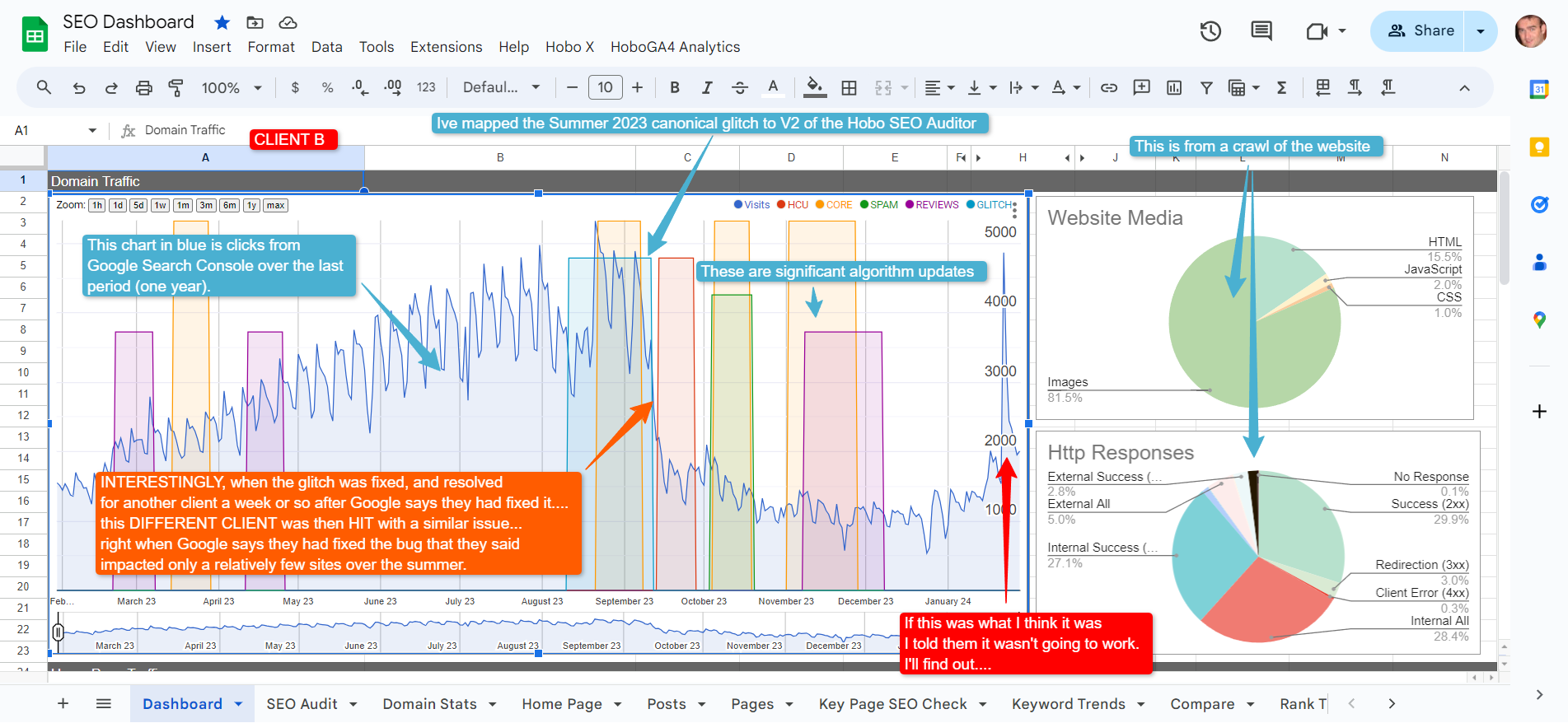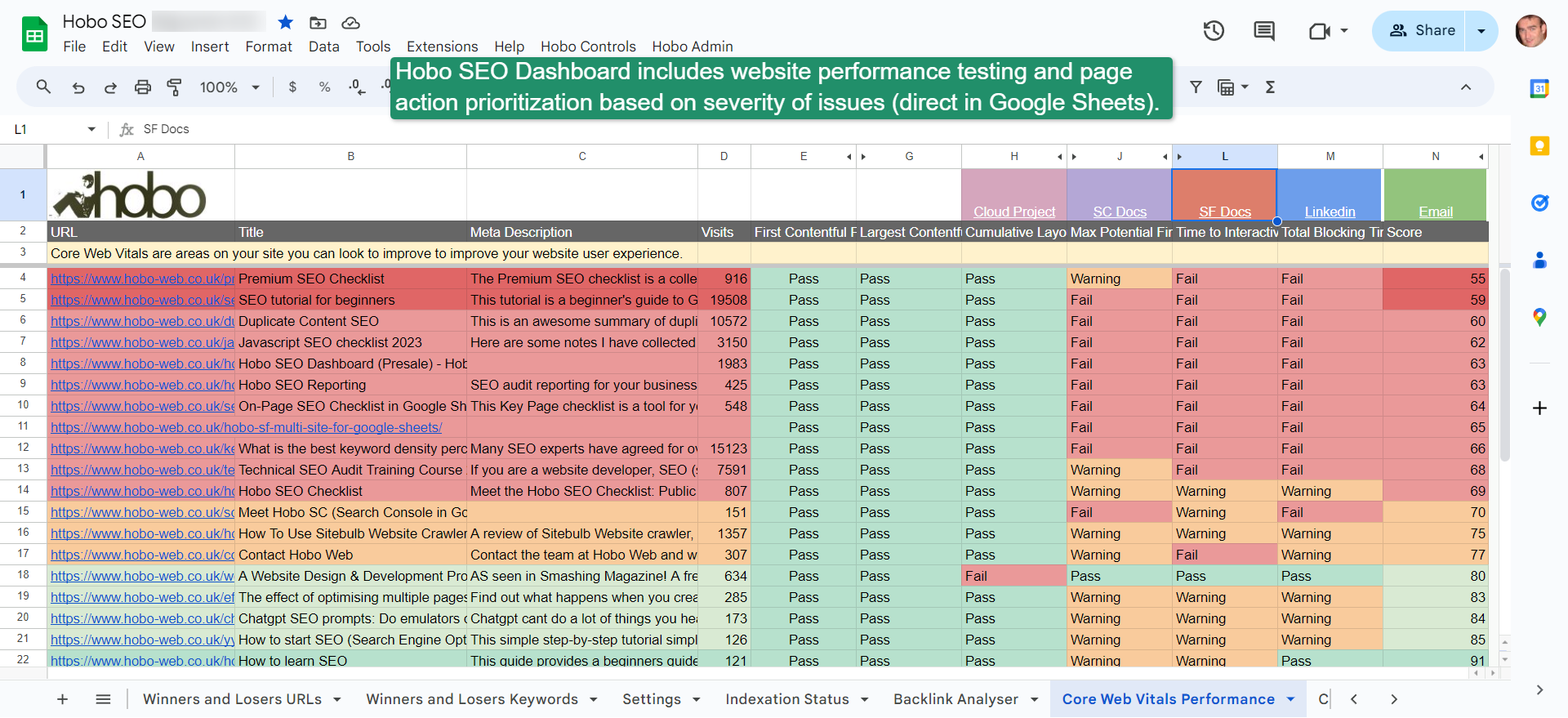Disclosure: Hobo Web uses generative AI when specifically writing about our own experiences, ideas, stories, concepts, tools, tool documentation or research. Our tool of choice is in this process is Google Gemini Pro 2.5 Deep Research (for text) and Google NotebookLM (for videos and audio). This assistance helps ensure our customers have clarity on everything we are involved with and what we stand for. It also ensures that when customers use Google Search to ask a question about Hobo Web software, the answer is always available to them, and it is as accurate and up-to-date as possible. All content was verified as correct. Edited and checked by Shaun Anderson, creator of the Hobo SEO Dashboard and founder of Hobo Web. See our AI policy.
SEO Dashboard is the quickest way to accurately audit your website SEO, track your website performance and manage your SEO project.
The Hobo SEO Dashboard V4 in Google Sheets features:
- Autonomous SEO task prioritisation.
- Private and secure reporting
- Client emailing system.
- No ongoing costs.
- Lifetime access for early birds.
- 100% secure and private.
Autonomous SEO Audit Reporting in Google Sheets
The entire aim of any fancy SEO reporting system should be to identify SEO priorities to focus on. That is the entire purpose of the Hobo SEO Dashboard.
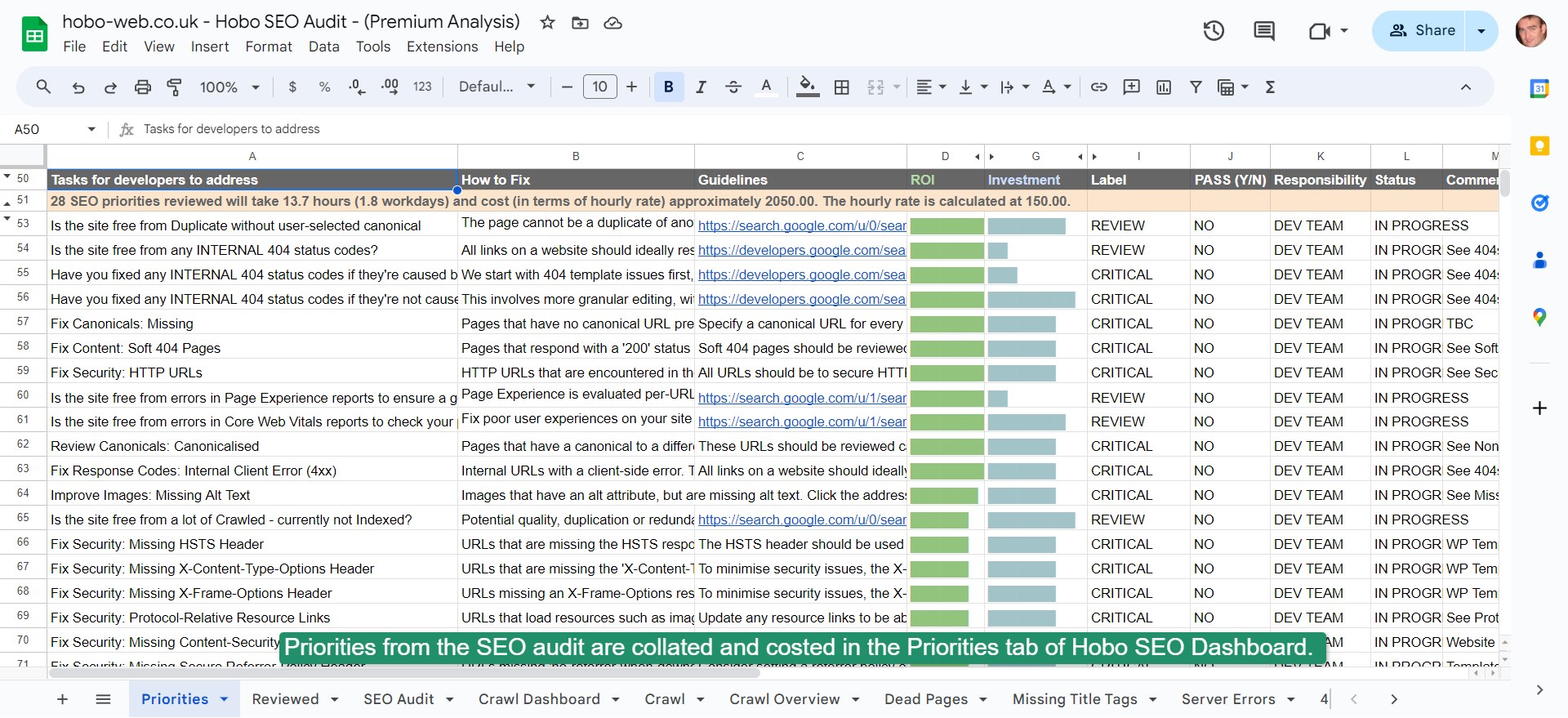
For SEO consultants and web development managers, the SEO Audit tab in the Hobo SEO Dashboard is designed to streamline and simplify your SEO workflow.
The tab is powered by the Hobo SEO Checklist system, designed to clarify SEO processes and keep you on track throughout your project lifetime.
Here’s how the SEO Audit tab in Hobo SEO Dashboard can transform your SEO processes:
- Centralised Project Management: The SEO Audit tab acts as your command centre. This is the central checklist for your SEO project to keep track of everything.
- Track Tasks and Completion: The tab lets you check off your SEO projects’ progress, marking tasks as complete as you go. This keeps everything organised and ensures that no crucial task is overlooked.
- Team Collaboration: If you’re managing a team, the SEO Audit tab offers features for task assignment and delegation. This ensures smooth collaboration and efficient distribution of work across your team.
If using Screaming Frog to crawl your website, some of your SEO audit tab will be pre-populated with Screaming Frog’s findings.
This is a checklist…. that checks itself.
NOTE: You perform manual SEO audits on the client version of your dashboard, not your central dashboard.
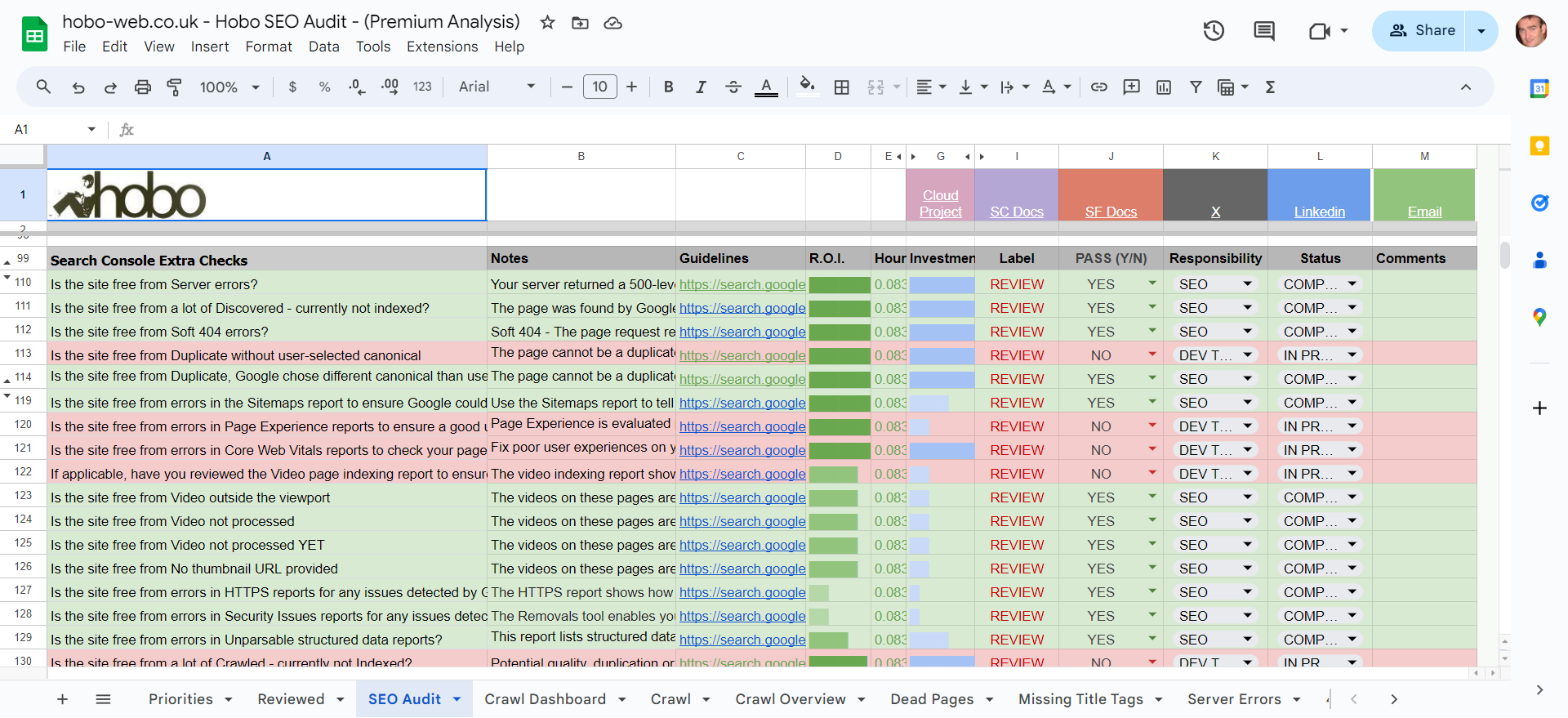
The Importance of a Manual SEO Audit
A manual SEO Audit remains critical for a thorough SEO audit.
Automation can’t fully capture the nuances of these key SEO elements:
- Content Quality: Evaluating the relevance, originality, and readability of your content requires human judgment.
- E-E-A-T (Expertise, Authoritativeness, Trustworthiness): These qualities are crucial for building trust with Google and users. Assessing E-E-A-T requires manual evaluation of factors like author credentials, content accuracy, and website reputation.
- User Experience: Tools can measure some aspects of user experience, but elements like navigation, page speed, and overall usability need human insight.
- Website Promotion: Identifying the most effective and ethical promotional strategies requires a deep understanding of your audience and the SEO landscape, something automation alone can’t provide.
- Spam Analysis: Detecting and addressing issues like doorway pages, sneaky redirects, and user-generated spam necessitates a careful manual review.
- Business-Specific Considerations: Every business has unique SEO needs. Tailoring your SEO strategy to fit your business goals and audience requires human expertise that goes beyond automated analysis.
The combination of the SEO Audit tab, the Hobo SEO Checklist, the Search Console, Analytics and Screaming Frog integration creates a powerful system for managing your SEO.
While these tools automate much of the process, human expertise is essential for a comprehensive and effective SEO audit.
Say goodbye to tedious manual reporting and hello to automated, client-ready reports that showcase your website’s successes and pinpoint areas for optimisation.
Meet the Hobo SEO Dashboard (Multi-Site Version)
Automatically track Google algorithm impacts and identify SEO priorities to deal with, using Google Search Console and Screaming Frog SEO Spider:
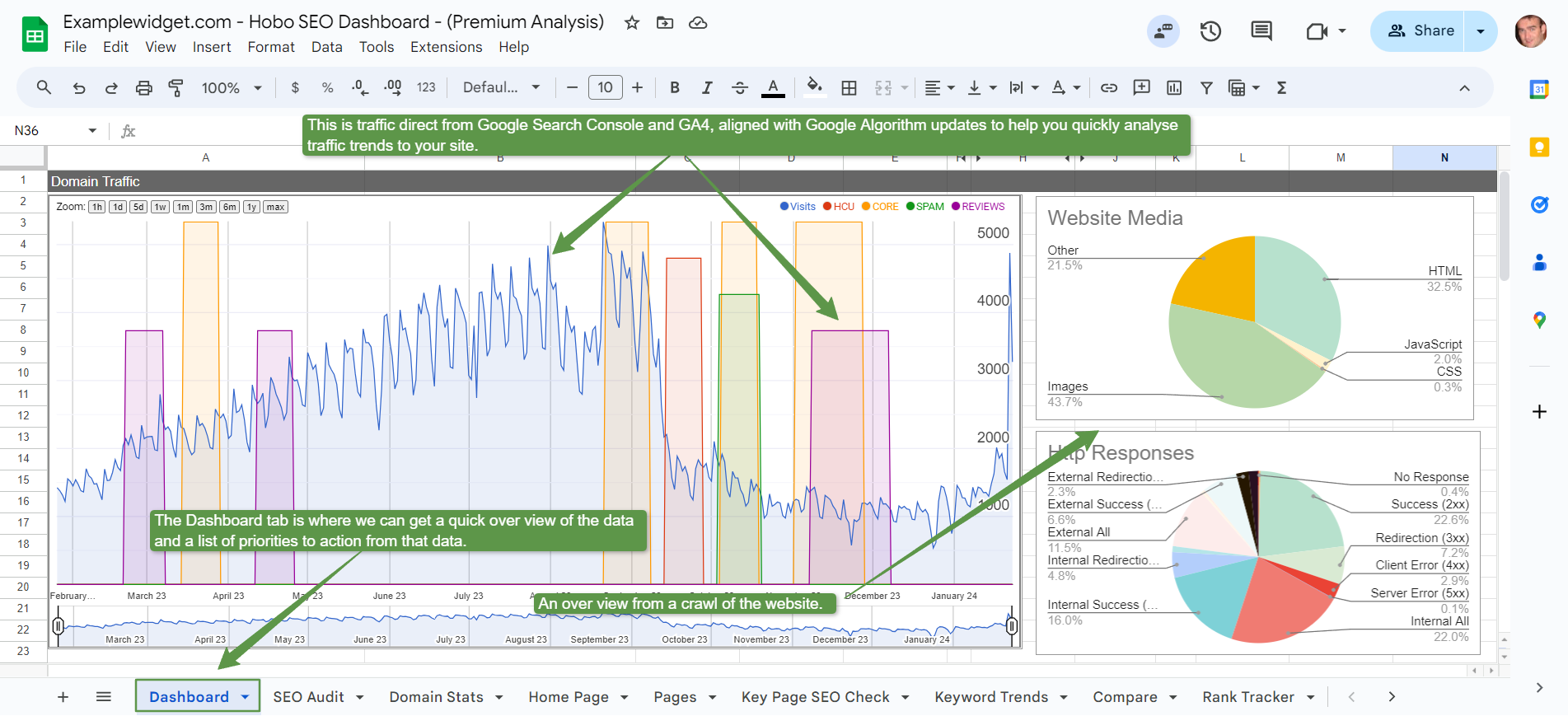
Objective: This article provides an in-depth analysis of the Hobo SEO Dashboard (Multi-Site version), focusing on its automation capabilities, technical underpinnings, target user profile, prerequisites, cost structure, and comparative positioning within the Hobo Web SEO tool suite.
The analysis addresses specific inquiries regarding reporting automation, crawling mechanisms, suitability for agencies versus in-house teams, handling of website sections, mandatory requirements like Google Accounts and Screaming Frog licenses, pricing, technical expertise needed, available support, and unique benefits concerning data privacy and cost savings relative to typical Software-as-a-Service (SaaS) SEO platforms.
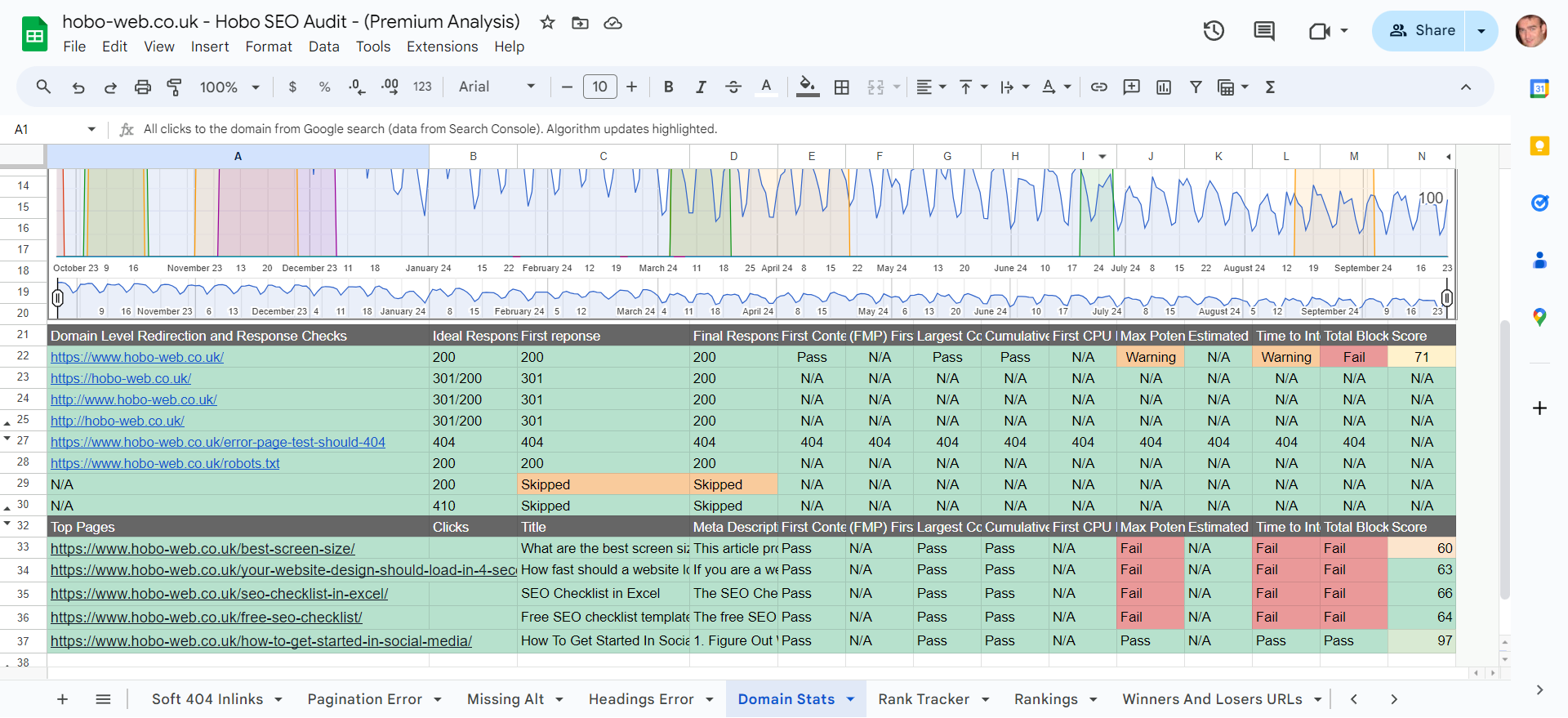
Methodology: The findings presented herein are derived exclusively from the analysis of the provided documentation snippets. The report synthesises factual information extracted from these sources to directly answer the user’s questions, without incorporating external knowledge or assumptions.
Report Structure: The report begins by examining the core functionality and automation features of the Hobo SEO Dashboard. It then defines the target audience and the necessary prerequisites for its use. Subsequent sections detail the cost, licensing model, and technical expertise required for setup and operation.
A comparative analysis follows, positioning the Hobo SEO Dashboard relative to other Hobo Web tools (Hobo SEO Auditor, Hobo EEAT Tool).
The report then discusses support resources, data privacy advantages, and cost-saving benefits. An analysis of the distinct Hobo SEO Dashboard Enterprise version is included before concluding with a summary of findings, strengths, and limitations.
Hobo SEO Dashboard – Core Functionality and Automation
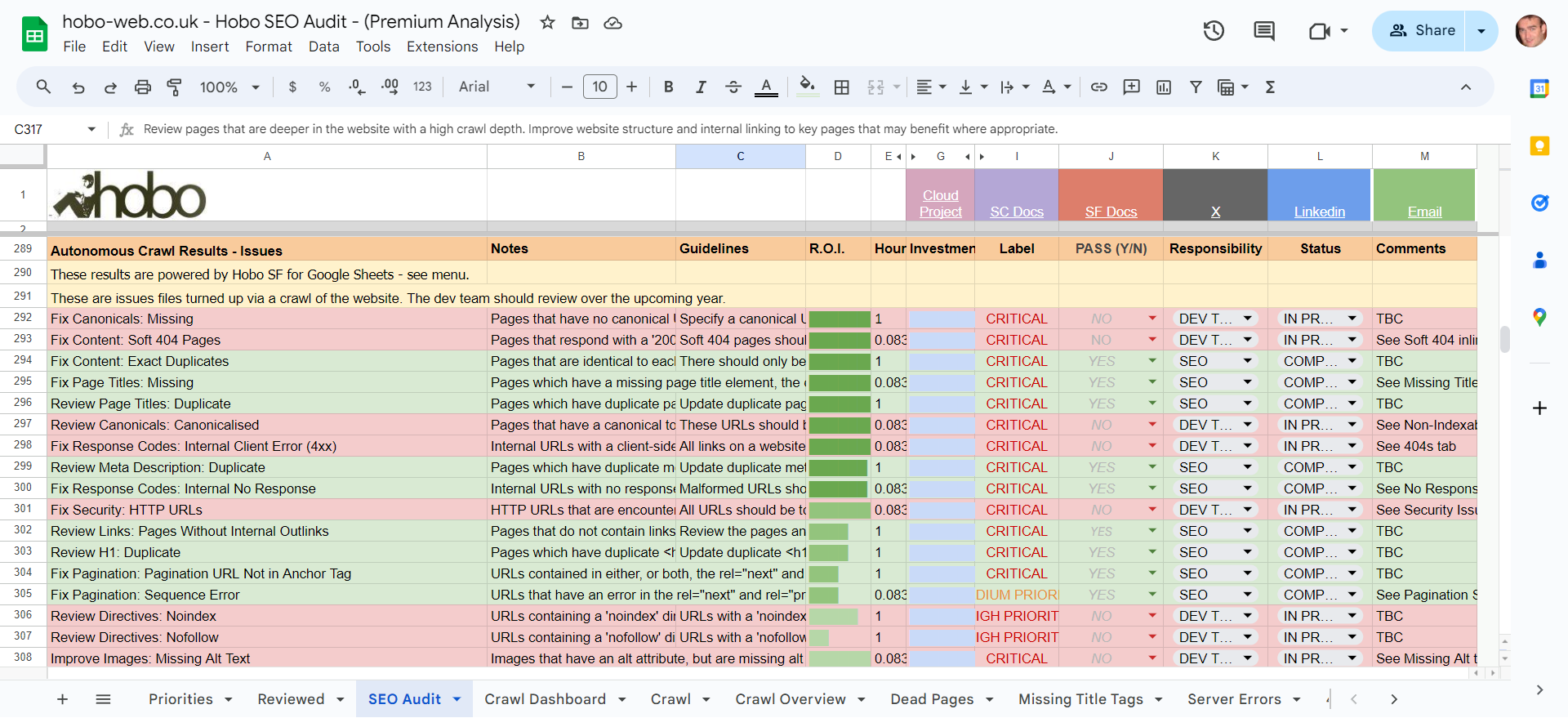
Overview: The Hobo SEO Dashboard Multi-Site is presented as a professional SEO audit and reporting system operating entirely within the user’s Google ecosystem, specifically using Google Sheets and Gmail. It is positioned as a cost-effective alternative to more expensive, often subscription-based, SEO tools, primarily achieving this through the automation of reporting and analysis tasks.
Automated SEO Reporting and Analysis Capabilities: The core value proposition of the Hobo SEO Dashboard Multi-Site lies in its automation of repetitive SEO reporting tasks, particularly for users managing numerous websites. Its primary automation function involves autonomously cycling through a list of client websites, as defined within the user’s Google Search Console (GSC) account.
For each site, it automatically generates what are described as “unique and sophisticated SEO reports”.
These reports provide actionable data, such as identifying the specific keywords driving traffic to a site, highlighting top-performing pages (“killing it”), and flagging pages that may require optimisation (“need a little love”).
Furthermore, the system can be configured to automatically distribute these generated reports via email to clients based on a user-defined schedule, streamlining client communication.
A significant automated analysis feature is the generation of specialised “Winners and Losers” reports.
Winners and Losers reports on pages and keywords
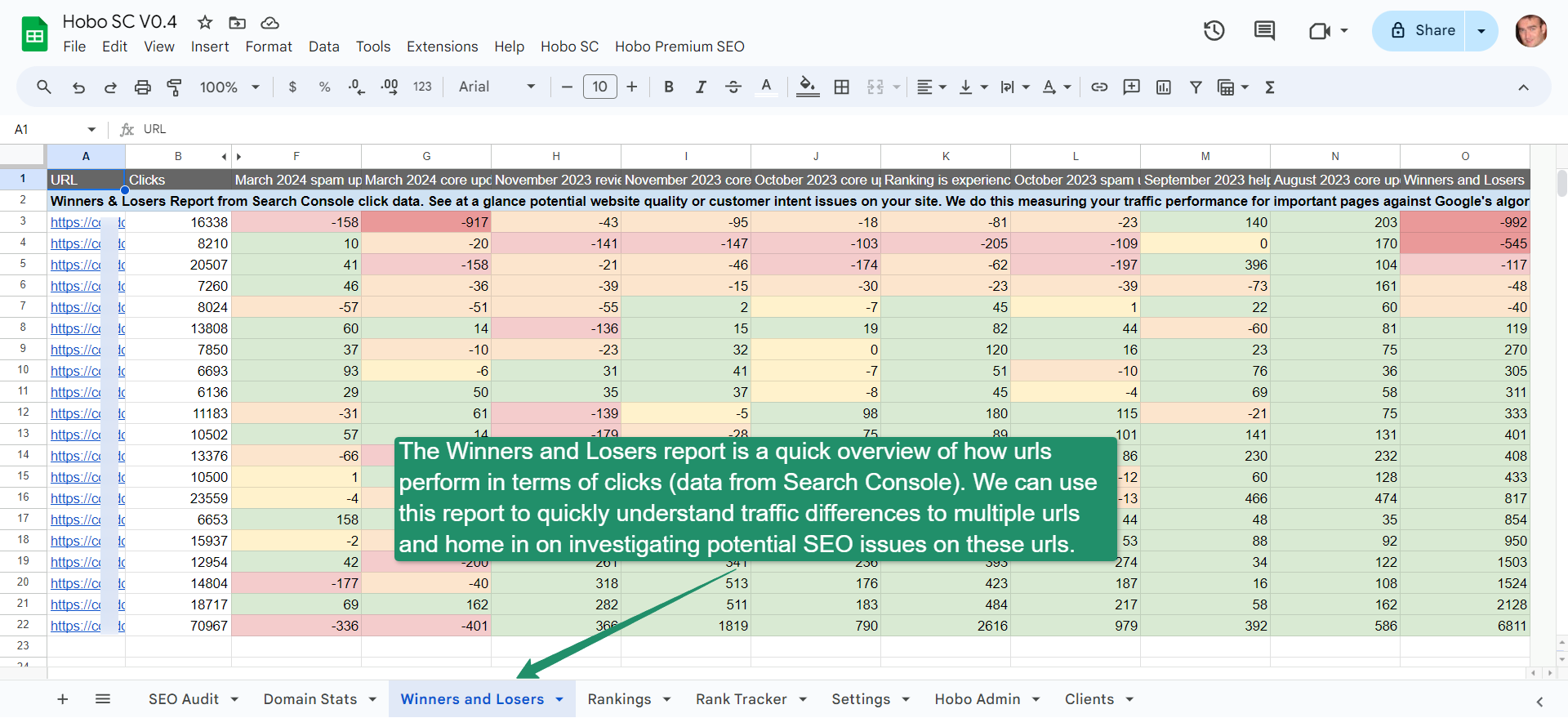
The Google Search Console Winners and Losers URLS Report in the Hobo SEO Dashboard provides a unique view of your website.
With it, you can easily see your website’s top-performing and worst-performing pages, allowing you to quickly take action to prioritise improvement.
This insightful report, seamlessly integrated with the Hobo SEO Dashboard, lets you unlock the secrets of your website’s search engine rankings with real-time tracking, algorithm impact analysis, and actionable insights.
Google Search Console Winners and Losers URLS Report are based on your own Search Console data.
The Winners and Losers reports are designed to help you prioritise which pages on your site to focus on improving
This functionality automatically tracks performance changes over specified periods, comparing key metrics like clicks, impressions, click-through rates (CTR), and average position.
This analysis is particularly useful for understanding the impact of significant Google algorithm updates (e.g., Core Updates, Spam Updates) on site performance, enabling users to prioritise remedial actions or capitalise on positive shifts.
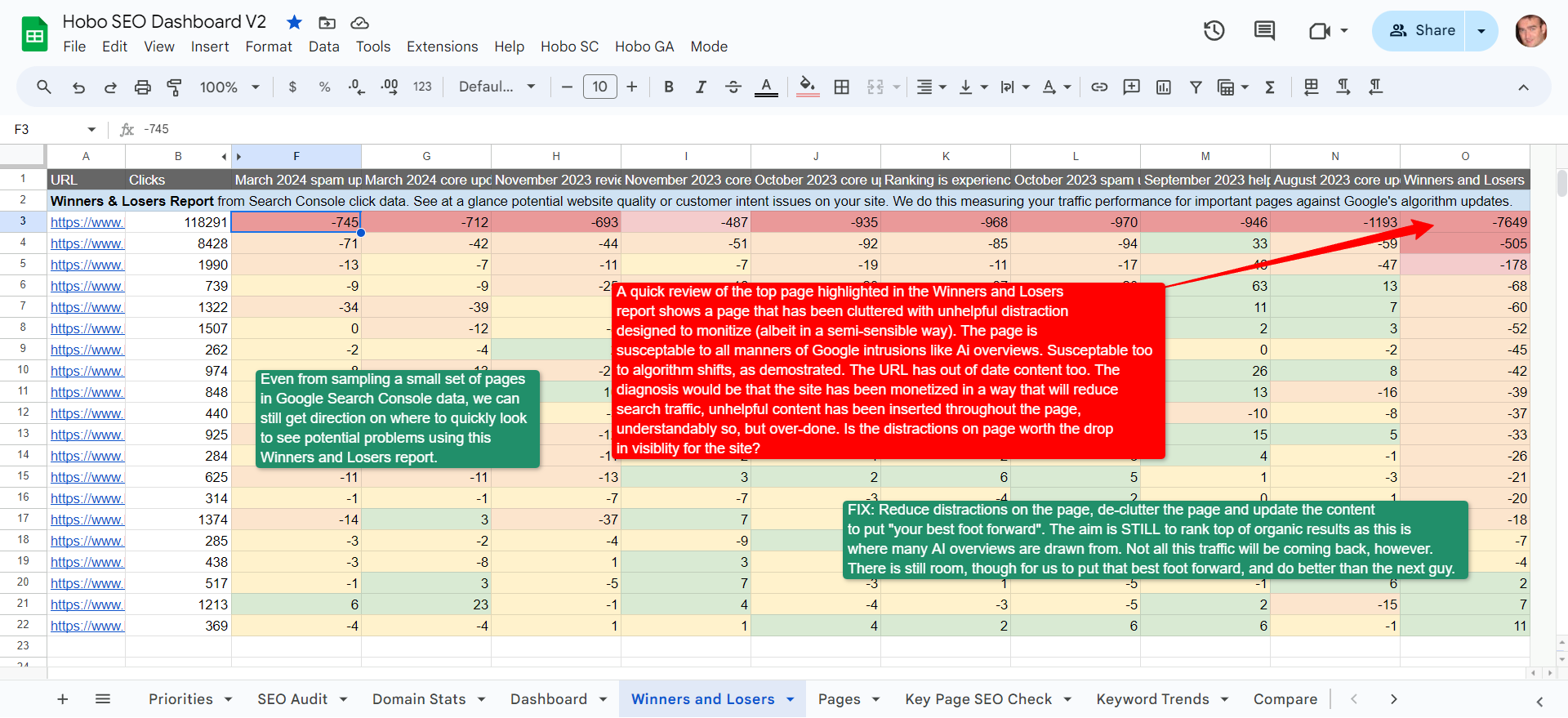
The dashboard also integrates insights from other Google APIs, such as Google Page Speed, incorporating this data to provide a more comprehensive (“holistic”) view of website performance within its reports.
Export, store, and track top keywords and URLS
Google permits you to export thousands of keywords you feature for (from which you get clicks or appear – called impressions).
This is where any professional keyword research project starts.
Hobo SEO Dashboard exports and stores all your keywords in your Keyword Bank sheet in Google Sheets.
With it, you can start to determine if there is a better configuration for optimising the site for specific keywords.
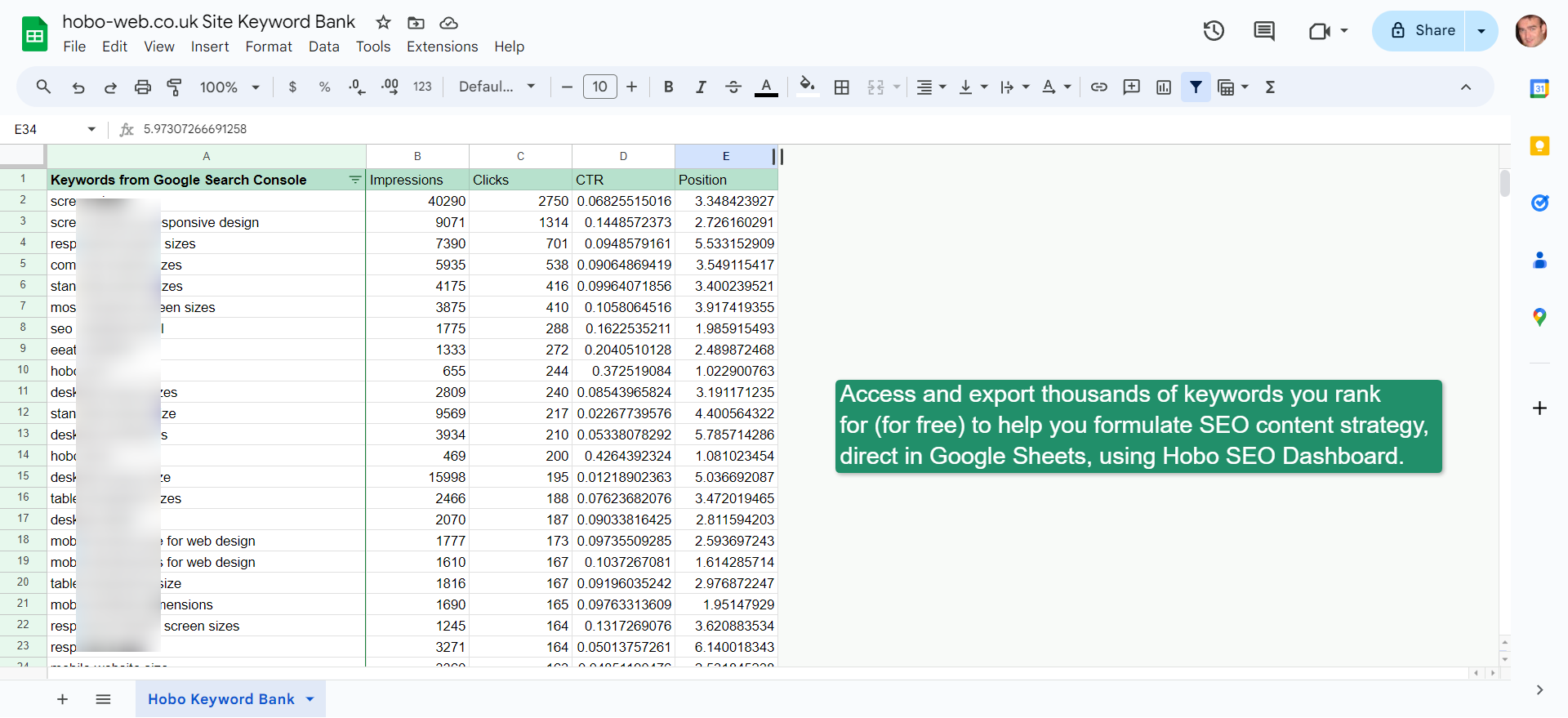
Analyse crawl data in a simple way
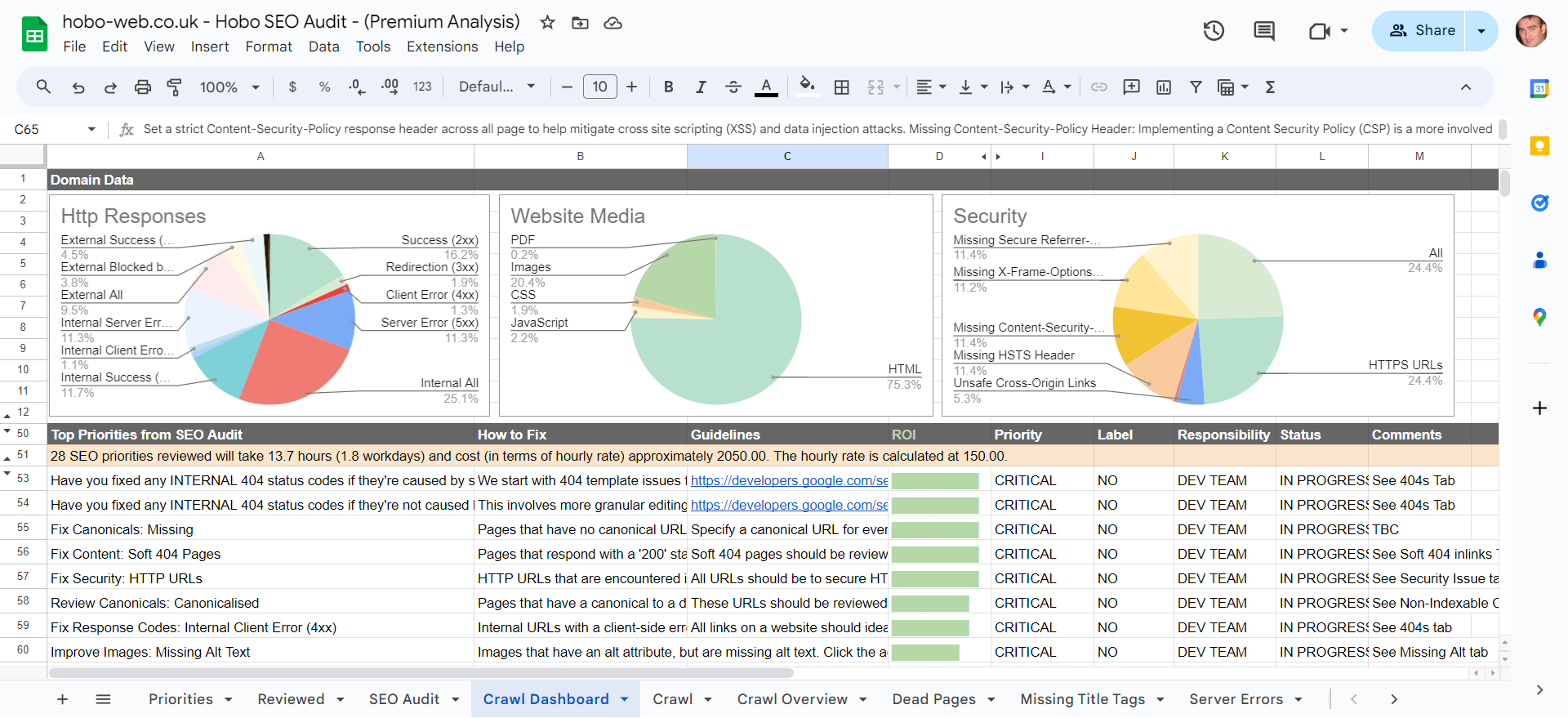
Beyond GSC data, the dashboard automates the processing of technical SEO data derived from Screaming Frog crawls.
This includes analysing crawl files stored in Google Drive to identify technical issues like broken internal links (resulting in 404 errors) and server-side problems (500 errors), which can negatively impact rankings and user experience.
The system can also be configured to automatically add new client sites to the dashboard based on Screaming Frog files it detects in the user’s Google Drive.
Once activated, the dashboard is designed to run autonomously, performing an initial setup (taking approximately an hour) and then continuously producing reports for all connected GSC accounts.
A key design principle is its efficiency in API usage; it is engineered to operate frugally, staying well within Google’s free API thresholds even when managing a large number of sites, making it suitable for use with a standard personal Gmail account without incurring extra API costs.
This focus on automating the collection, analysis (especially trend/impact analysis via “Winners and Losers”), and reporting of data from existing sources like GSC and Screaming Frog defines its approach to streamlining workflows for multi-site management.
Website Crawling Mechanism and Screaming Frog Integration: Crucially, the Hobo SEO Dashboard does not perform its own website crawls.
Crawl insights for your website using Screaming Frog Scheduling 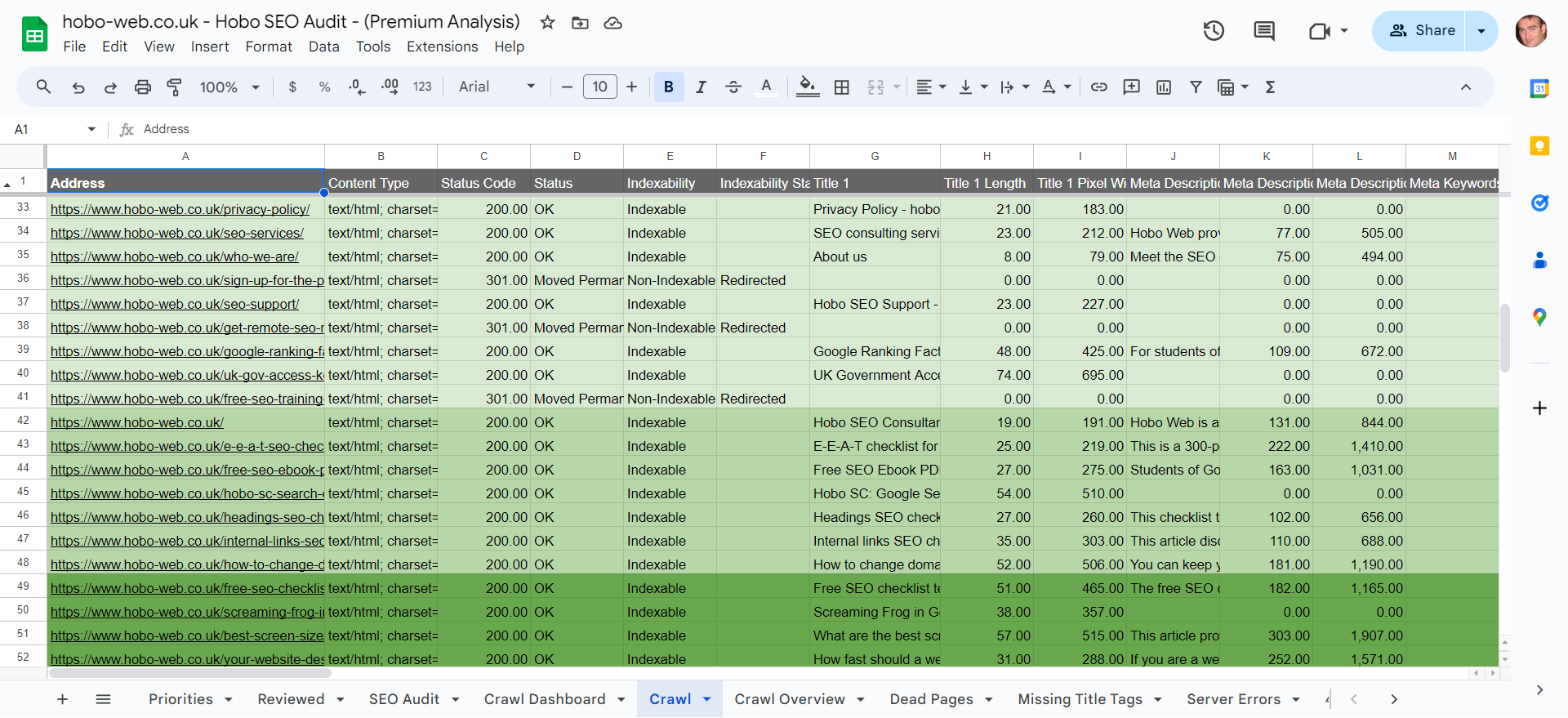
Its technical SEO analysis capabilities are entirely dependent on data imported from external website crawlers, with Screaming Frog SEO Spider being the specifically mentioned tool. Hobo SEO Dashboard is not affiliated in any way with Screaming Frog Spider, except that we love it.
The workflow involves the user running a licensed version of Screaming Frog separately to crawl their target website(s).
Screaming Frog maps out the site structure, pages, and elements. This crawl data is then exported from Screaming Frog, often automatically, into the user’s Google Drive, which serves as a central repository for the raw data.
The Hobo SEO Dashboard, particularly through its integrated Hobo SF component, accesses these Screaming Frog export files directly from the user’s Google Drive.
It then processes this data to perform technical analysis and populate relevant sections of its reports.
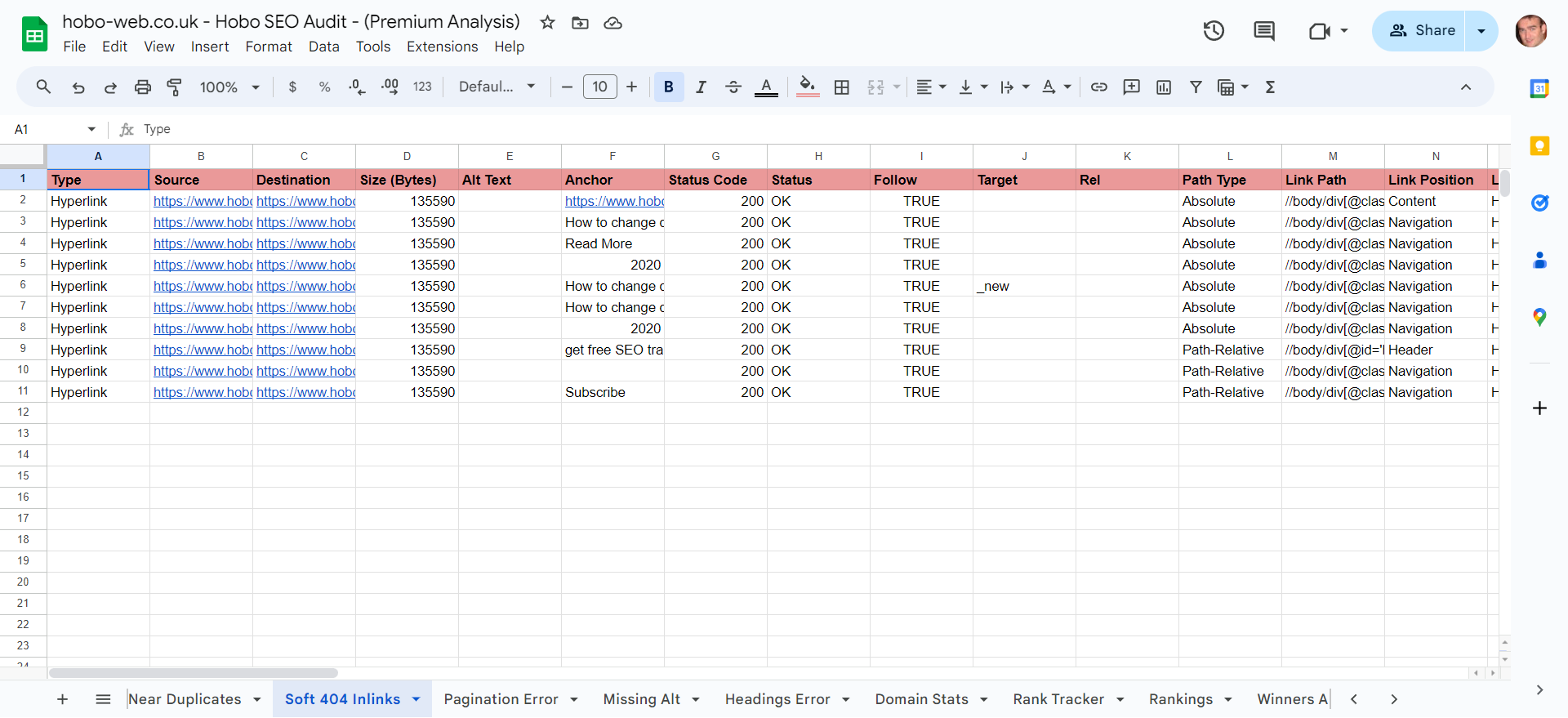
The integration extends to file management, with features designed to automatically clean up the Google Drive workspace by moving processed Screaming Frog files to the trash (where they remain recoverable for 30 days).
Users also retain the ability to manually trigger the import and analysis of specific Screaming Frog report files directly into the dashboard as needed.
This dependency establishes the Hobo SEO Dashboard as an analysis, automation, and reporting layer built on top of Screaming Frog data, rather than a self-contained crawling solution.
To get the most out of Hobo SEO Dashboard MultiSite Lifetime, you need a Screaming Frog Licence, although Hobo will run reports without this deep technical data from SF.
It is designed to be an efficient analysis tool for SEO professionals who work with the best data sources. That is Google Search Console and Screaming Frog data.
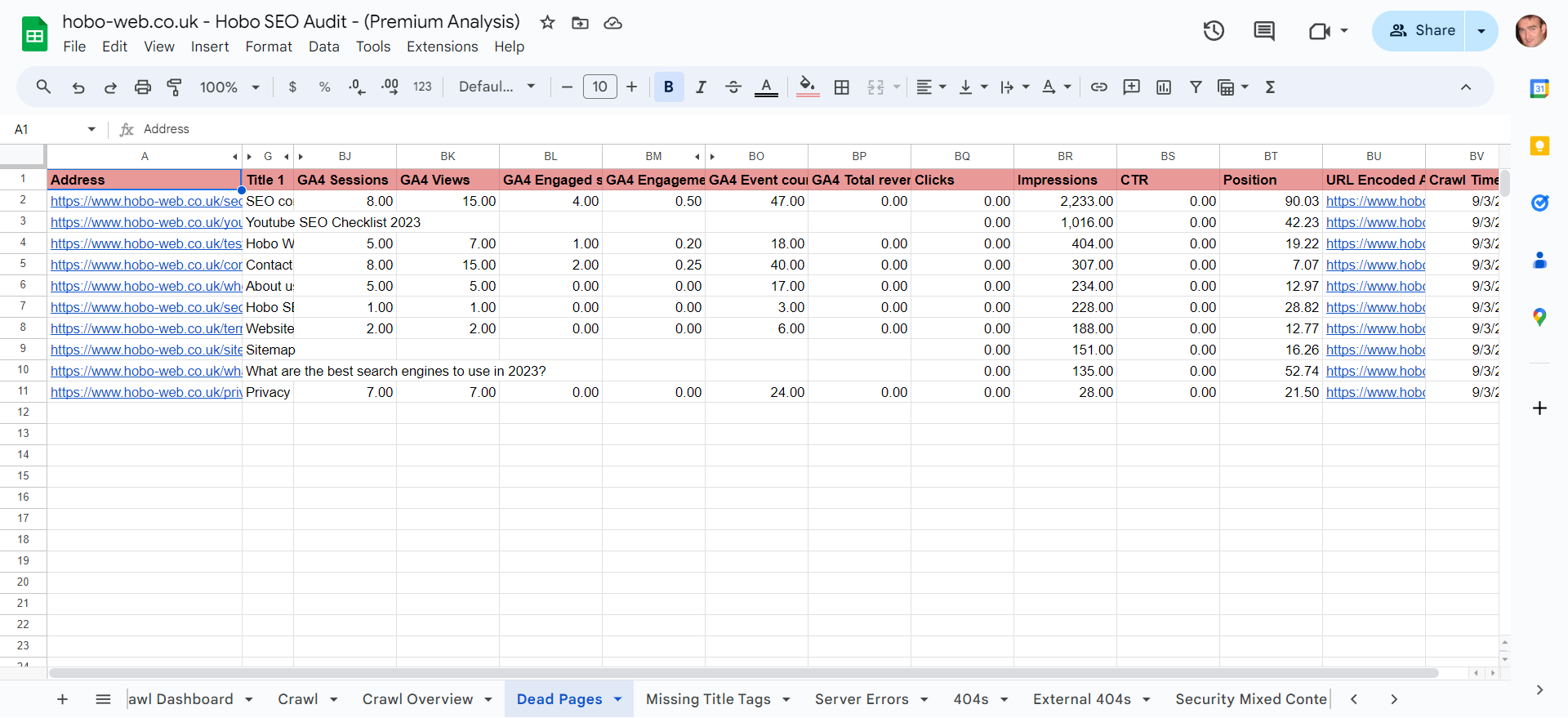
Analysis Capabilities for Specific Website Sections or Subfolders: The standard Hobo SEO Dashboard Multi-Site version, as described in the available documentation, primarily focuses on analysing entire websites represented as properties within Google Search Console.
The documentation does not detail a built-in mechanism within this standard version for isolating and analysing specific sections or subfolders (e.g., a blog within /blog/, a shop within /shop/) of a single large, complex website.
The basic Hobo SEO Dashboard can be configured for a single site. Just create new profiles in Search Console for specific subfolders, and add the subfolder to your Dashboard as a distinct “client”.
For larger sites and sites with millions of pages, this specific capability—granular analysis of website subsections—is the core feature of the Hobo SEO Dashboard Enterprise service version (although you can do this yourself too with the basic Hobo SEO Dashboard).
This distinct offering uses the same underlying Hobo SEO Dashboard Multisite technology but involves a unique, expert configuration process.
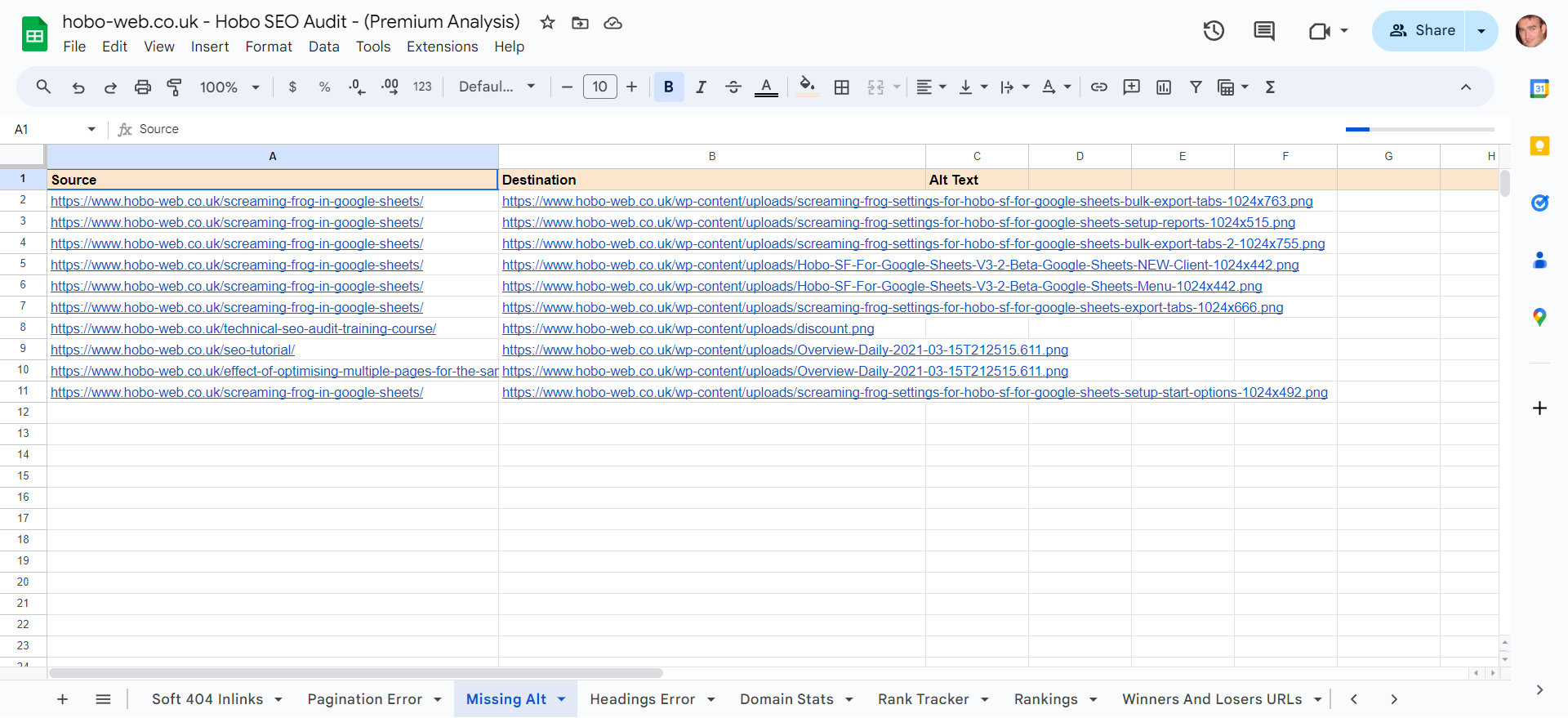
This configuration allows the tool to treat designated key subfolders within a single large domain as if they were separate, distinct entities for analysis purposes.
Achieving this requires a specialised setup and the integration of segmented data feeds from GSC (and potentially section-specific Screaming Frog crawls) for each targeted subfolder
Therefore, analysing specific website sections is positioned as an advanced capability available through the dedicated Enterprise managed service, not a standard feature of the self-serve Multi-Site Dashboard product.
This differentiation acknowledges the unique challenges of managing large, monolithic websites compared to overseeing multiple smaller, distinct sites.
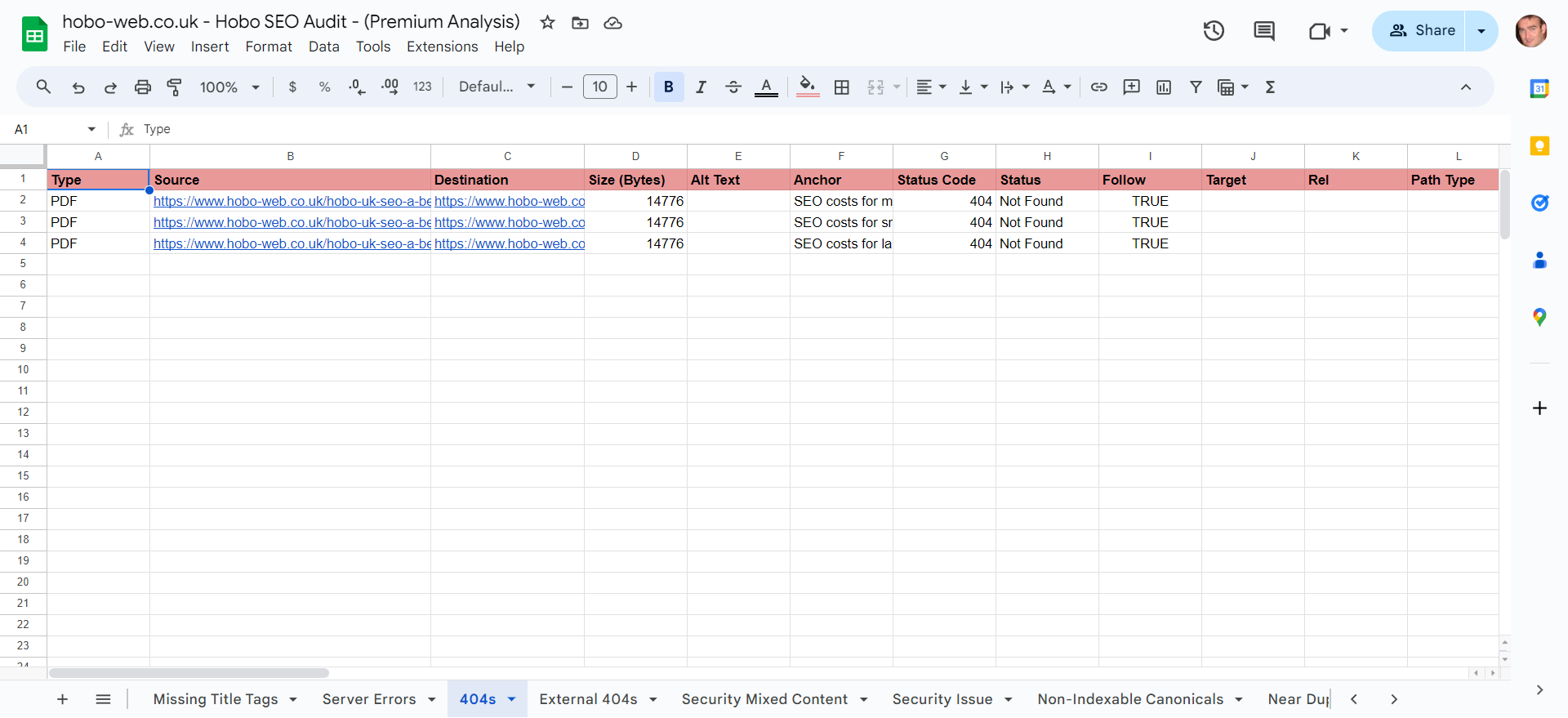
Hobo SEO Dashboard is a software as a service in your own account. Hobo SEO Auditor is a software as a service in Hobo’s account, meaning no api setup challenges for you, although you share Google Search Console access with us under NDA. Hobo SEO Dashboard Enterprise is a software as a service and a consultancy and technical service, in your own account, that Hobo Web sets up for you (and manages on your behalf), with specific NDA and service level agreements.
Target Audience and Prerequisites
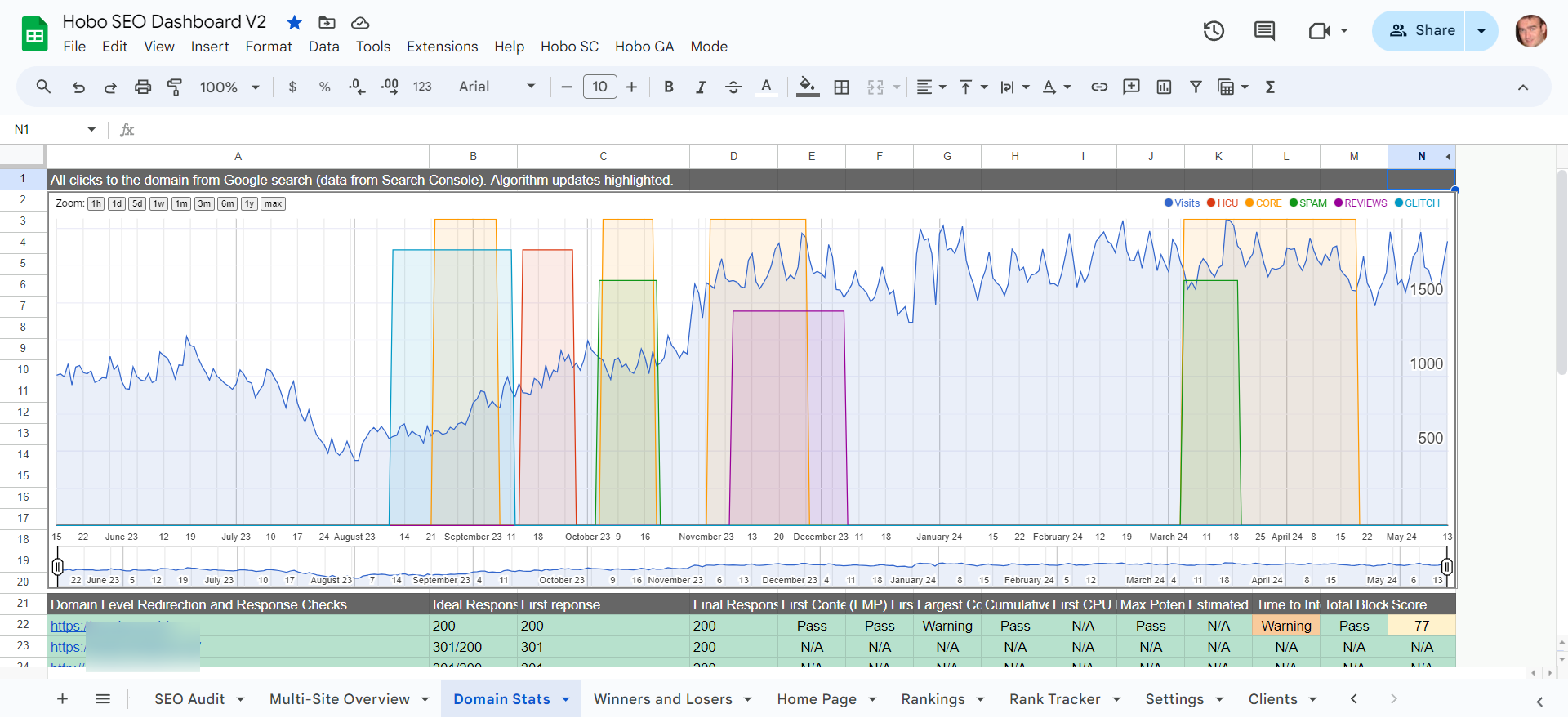
Primary User Profile: SEO Agencies vs. In-House Teams: The documentation consistently positions the Hobo SEO Dashboard Multi-Site as being explicitly built for entities managing multiple websites.
Customers include “website development companies, agencies and SEO professionals who have a lot of websites to manage in Search Console”. It is noted as being used by 100s of SEO professionals who collectively manage “tens of thousands of sites” using the Hobo SEO Dashboard.
It is also deemed suitable for “SEO consultants, and in-house marketing or website managers” who handle multiple sites.
The emphasis on efficiently managing and reporting across numerous client sites is a recurring theme.
While an in-house team managing a single large website could technically use the Multi-Site version (treating their single site as one ‘client’ property), the tool’s core design, automation features (like cycling through GSC properties), and overall value proposition are clearly optimized for the breadth required by agencies or consultants managing multiple domains.
For organisations focused on a single, large, complex website, particularly those needing analysis of distinct sections or subfolders, the Hobo SEO Dashboard Enterprise version is explicitly presented as the more appropriate solution.
This distinction suggests a clear segmentation: the Multi-Site version excels in managing many separate sites, while the Enterprise version is tailored for the depth required within one large site.
A single-site version of the Hobo SEO Dashboard without client cycling is in the works.
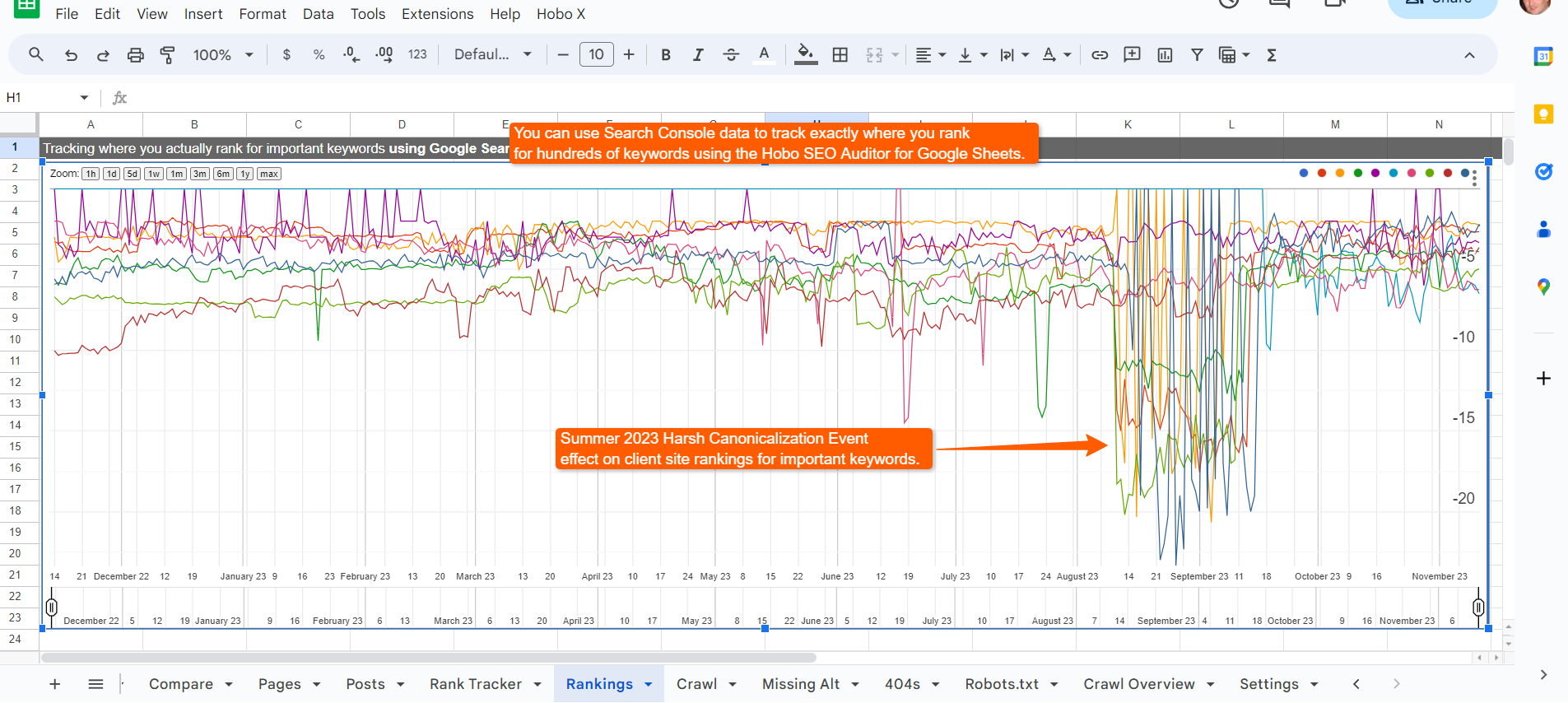
Mandatory Prerequisites: To utilise the Hobo SEO Dashboard Multi-Site, users must meet specific prerequisites:
- Google Account: A Google account is essential. This can be a standard, personal Gmail account or a Google Workspace account. The dashboard operates entirely within the Google ecosystem, running as Google Apps Script connected to Google Sheets and potentially interacting with Gmail for report distribution and Google Drive for storing and accessing Screaming Frog data. Furthermore, setup requires interaction with the Google Cloud Platform (GCP) to create a project and enable necessary Google APIS, including the Google Search Console API, Google Drive API, and Google Sheets API, linking these to the Apps Script project. Access to the Google Search Console properties intended for monitoring is, naturally, fundamental.
- Paid Screaming Frog License: A separate, paid license for the Screaming Frog SEO Spider software is explicitly required to leverage the dashboard’s full technical SEO analysis capabilities. While the dashboard integrates with and processes Screaming Frog data, it does not include a crawling function itself, nor does the Hobo Dashboard license cover the cost of the Screaming Frog license, which must be purchased independently. The Hobo SF tool, described as part of the Dashboard suite, enhances the use of Screaming Frog data but presupposes the user already possesses a valid license. Hobo SEO Auditor allows you to import Screaming Frog files too if you have a licence.
The fundamental reliance on the Google ecosystem shapes the operational environment, while the mandatory Screaming Frog license introduces an external software dependency and associated recurring cost.
This positions the Hobo Dashboard not as a fully standalone SEO platform, but as an automation and reporting enhancement primarily for users already invested in the Screaming Frog and Google ecosystems.
Cost, Licensing, and Technical Requirements
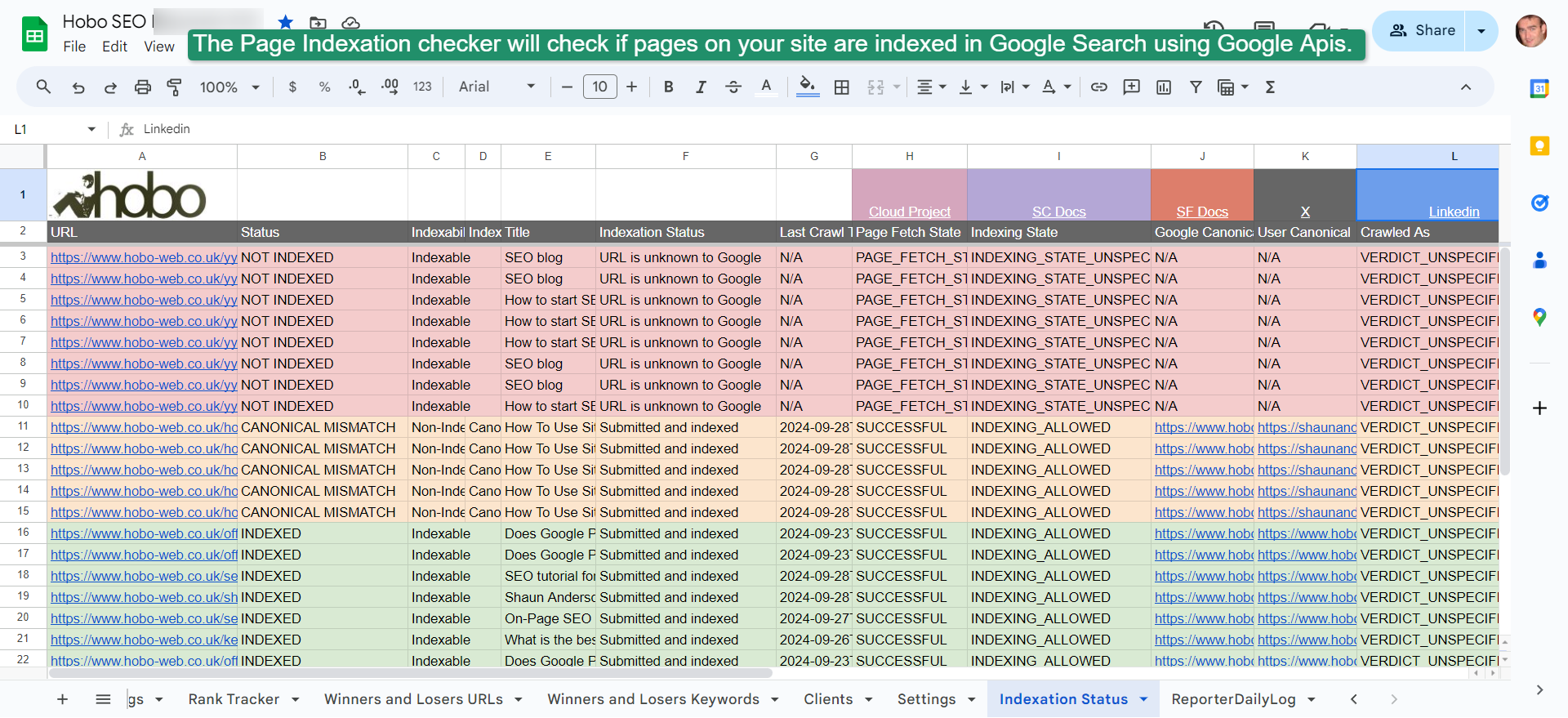
Hobo SEO Dashboard (Multi-Site): Pricing and License Structure: The Hobo SEO Dashboard Multi-Site employs a distinct licensing model compared to many mainstream SEO SaaS platforms.
- Licensing Model: It is offered as a one-time purchase granting a lifetime license to use the software. The documentation explicitly states there are “no subscription fees” associated with the dashboard itself.
- Exact Cost: Based on a comparative cost analysis table provided in the documentation, the price for the Hobo SEO Dashboard (Multi-Site, referred to as “Hobo 1” in the table) is £499.
- Total Cost Consideration: Prospective users must factor in the mandatory external cost of the Screaming Frog license. The total cost of ownership is therefore the one-time £499 for the Hobo Dashboard plus the recurring annual fee for Screaming Frog (estimated at £199 per year in the provided comparison). Also you have minimal Google Workspace fees to account for.
This lifetime license model represents a significant potential cost saving over the long term compared to the recurring subscription fees of platforms like Ahrefs or SEMrush.
However, the necessity of maintaining a separate, paid Screaming Frog license introduces an ongoing cost component.
The pricing strategy appears designed to appeal to users, particularly agencies, who are already using Screaming Frog and seek a lower long-term investment for reporting automation.
Required Technical Expertise for Setup and Operation: Setting up the Hobo SEO Dashboard Multi-Site requires a level of technical proficiency beyond simply granting access to Google Search Console (a process characteristic of the simpler Hobo SEO Auditor ).
The setup process necessitates direct interaction with the Google Cloud Platform (GCP).
Users must either create a new GCP project or select an existing one, navigate the GCP console to find and enable specific APIS (Google Search Console API, Google Drive API, Google Sheets API), and configure an OAuth consent screen, specifying details like user type, app name, and contact information.
The Google Apps Script project that powers the dashboard must then be manually linked to this configured GCP project.
While the dashboard is engineered for autonomous operation after this initial setup, the configuration phase requires familiarity with Google’s developer environment, understanding API concepts, and managing permissions via OAuth.
Users also need to be comfortable with the dashboard’s specific operational workflows, such as the automatic movement of processed Screaming Frog files to Google Drive’s Trash folder.
The documentation itself suggests a non-trivial learning curve, describing it as a “sophisticated system”.
It explicitly advises caution for “SEO beginners” or individuals who are “uncomfortable with the technical complexities of script permissions, Drive workflows, or detailed SF export setup”.
This indicates that a moderate level of technical confidence and willingness to engage with cloud platform configuration and API settings are necessary for successful implementation.
This technical threshold may present a barrier for some users but offers greater control and data privacy for those equipped to handle the setup.
Comparative Analysis: Hobo Web SEO Tool Suite
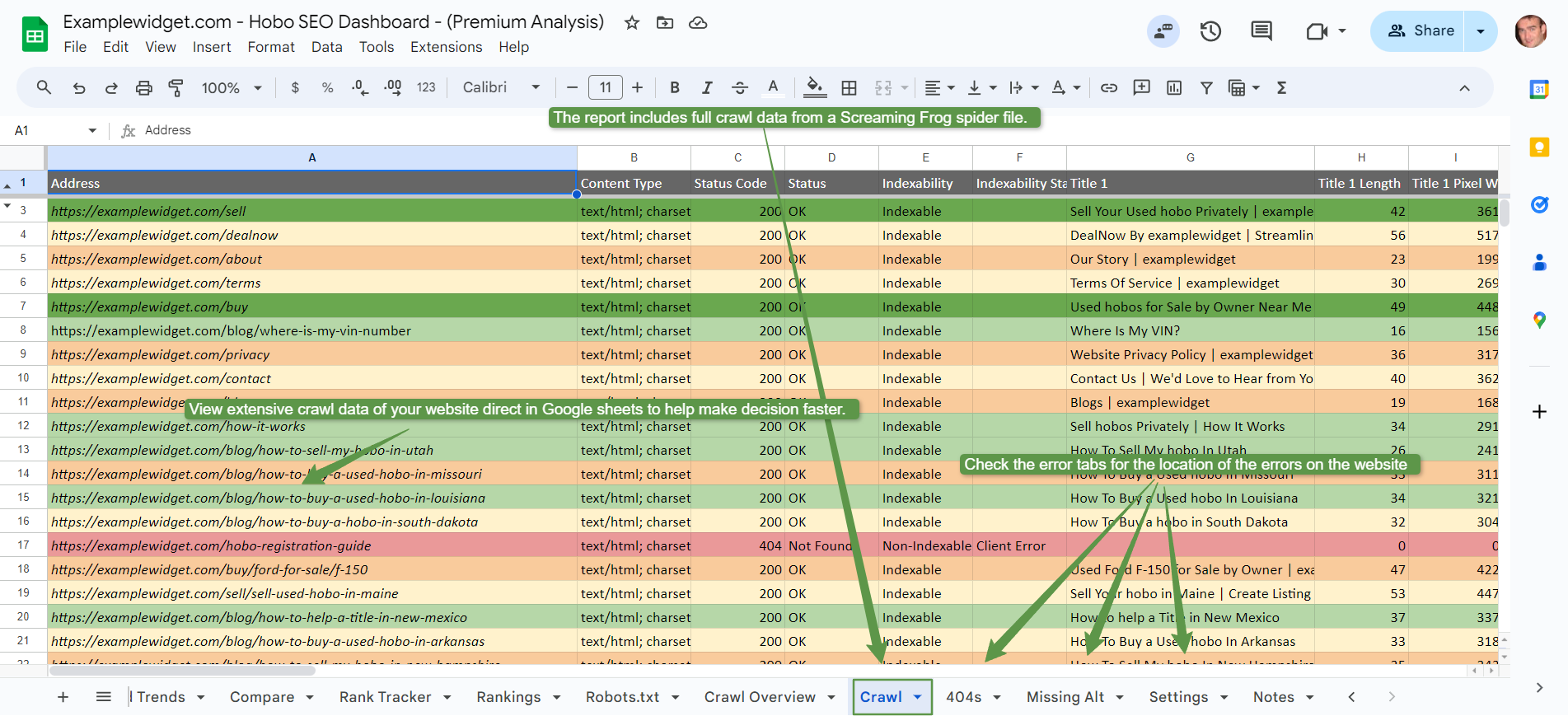
The Hobo Web product suite includes several distinct SEO tools. Understanding their differences is crucial for selecting the appropriate solution.
Hobo SEO Dashboard vs. Hobo SEO Auditor:
- Functionality: The SEO Dashboard is a comprehensive, self-hosted system (within the user’s Google account) designed for multi-site SEO reporting and auditing. It integrates and processes data from both GSC and Screaming Frog, features a unique “Winners and Losers” analysis linked to algorithm updates, allows scheduled client reporting via email, and includes the Hobo SF functionality for advanced Screaming Frog data handling. It requires user configuration involving GCP and APIS but offers full control over data and processes. The SEO Auditor, in contrast, is a simpler, managed reporting tool. Hobo SEO Auditor requires the user to grant Hobo Web access to their GSC account (under an NDA). Its primary focus is on monitoring Google algorithm impacts on traffic and rankings, identifying top-performing/declining pages and keywords, and checking page indexing status based on GSC data. It boasts a simpler setup with “No API to set up.. No configuration” beyond your contact details required from the user, and is tailored for those who prefer not to analyse crawl data directly. While it can incorporate scheduled crawl analysis, this still requires the user to possess a Screaming Frog license. You can read more about Hobo SEO Auditor Service Level Terms. It explicitly does not utilise AI (As of April 2025, no Hobo Web product uses AI in any way unless specifically stated that it does. The aim is ultimately to plug in Gemini, but the robot systems of Hobo SEO Dashboard are totally separate from any AI.
- Cost/Licensing: The Dashboard has a one-time lifetime license fee (£499) plus the recurring cost of a separate Screaming Frog license bought separately on the Screaming Frog website. The Auditor operates on a recurring monthly subscription model (£99/month for early birds), although it grants lifetime access to the reports generated during the subscription period.
- Data Privacy: The Dashboard keeps all user data securely within the user’s own Google environment. The Auditor requires granting Hobo Web access to the user’s GSC account, meaning Hobo Web processes this data, although the final reports reside in the user’s Google Sheets.
- Summary: The choice between the Dashboard and Auditor hinges on user priorities. The Dashboard offers greater control, deeper technical analysis capabilities (via mandatory SF integration), and potentially lower long-term costs, but demands technical setup skills and a separate SF license. The Auditor provides simplicity, ease of setup, and focuses on GSC data interpretation and algorithm impact, but uses a subscription model and requires trusting Hobo Web with GSC access under NDA, Non-Compete and confidentiality agreements, where specifically agreed.
Hobo SEO Dashboard vs. Hobo EEAT Tool:
- Functionality: These tools serve fundamentally different purposes. The Dashboard is a broad SEO monitoring and auditing platform covering GSC performance, technical site health (via Screaming Frog), and algorithm impact analysis across multiple sites. The Hobo EEAT Tool is a highly specialised utility focused solely on generating essential website policy documents (like privacy policies, terms of service, about us pages) designed to align with Google’s Quality Rater Guidelines concerning Experience, Expertise, Authoritativeness, and Trustworthiness (EEAT). It functions by taking user-provided business information from a Google Sheet and automatically populating a predefined template within Google Docs to create these policy forms. Its goal is to help sites demonstrate legitimacy and avoid issues related to the “Disconnected Entity Hypothesis“.
- Cost/Licensing: The Dashboard has its £499 lifetime license fee (plus SF costs). The Hobo EEAT Tool is sold separately. While an “Early-bird Price” is mentioned, the cost is £99 per year subscription confirmed by the seller. Notably, purchasing the EEAT Tool during the early-bird offer includes a free report generated by the Hobo SEO Dashboard, suggesting a promotional link between the products.
- Summary: The Dashboard and EEAT Tool are not competitors but rather complementary components addressing different facets of SEO and website compliance. The Dashboard handles ongoing performance tracking and technical audits, while the EEAT Tool provides a specific solution for generating foundational policy documents crucial for demonstrating credibility according to Google’s guidelines.
Comparative Overview Table:
| Feature | Hobo SEO Dashboard (Multi-Site) | Hobo SEO Auditor | Hobo EEAT Tool |
|---|---|---|---|
| Core Functionality | Multi-site SEO reporting & auditing, GSC/SF analysis, Algo impact | Single-site GSC monitoring, Algo impact reporting, Winners/Losers | Generates website policy documents aligned with Google EEAT guidelines |
| Primary Data Source(s) | Google Search Console, Screaming Frog exports (via Google Drive) | Google Search Console (requires access grant), Optional SF for crawl analysis | User input via Google Sheet |
| Crawling Mechanism | Relies on external Screaming Frog crawl data | Does not crawl; uses GSC data (optional SF analysis) | N/A |
| Target User | Agencies, consultants, multi-site managers | Users wanting simple GSC monitoring & algo impact reports without deep config | Site owners needing EEAT-compliant policy documents |
| Setup Complexity | Moderate (Requires GCP/API config, SF setup) | Very Low (Grant GSC access, no user config needed) | Very Low (Enter data in Sheet, run script) |
| Licensing Model | One-time Lifetime License | Monthly Subscription | Yearly Subscription |
| Stated Cost | £499 (+ recurring SF license cost) | £99/month (early bird) | £99/year (early bird) |
| Data Privacy Model | 100% Private. Data stays entirely within the user’s Google environment | Requires granting Hobo Web under NDA access to GSC data (processed by Hobo) | User data processed by script within the user’s Google environment (Sheet to Doc) |
Support, Data Privacy, and Cost-Saving Benefits
Available Support Resources and Documentation: The provided documentation highlights several resources offered by Hobo Web that contribute to user support and knowledge, and specific, dedicated support channels exist for The Hobo SEO Dashboard as accessed in the Hobo SEO Dashboard Overview, Hobo SEO Dashboard Costs, Hobo SEO Dashboard Privacy, How to Run Hobo SEO Dashboard and How to Set Up Hobo SEO Dashboard.
See also How to Set Up your Google Search Console API, how to set up Google Search Console in Hobo SEO Dashboard and How to Set Up Screaming Frog in Hobo SEO Dashboard.
Hobo Web provides general SEO resources, including a widely promoted “Free SEO Checklist” and a “Free SEO course,” both delivered via email subscription.
A more comprehensive “Hobo Premium SEO Checklist” is available as a one-time purchase (£180) with lifetime updates. Additionally, a “Hobo Pro SEO Audit course” is offered through daily emails over 12 weeks, teaching audit methodologies using GSC, Hobo checklists, and other tools.
The Hobo Web website contains articles that serve as documentation, including specific guides like “The Domain Stats tab in Hobo SEO Dashboard“.
YouTube videos demonstrating Hobo tools also exist. A general “Hobo SEO Support” page aggregates links to these various tools and services, and the Hobo Customer Portal and Hobo Web Privacy policy explain how we handle your site.
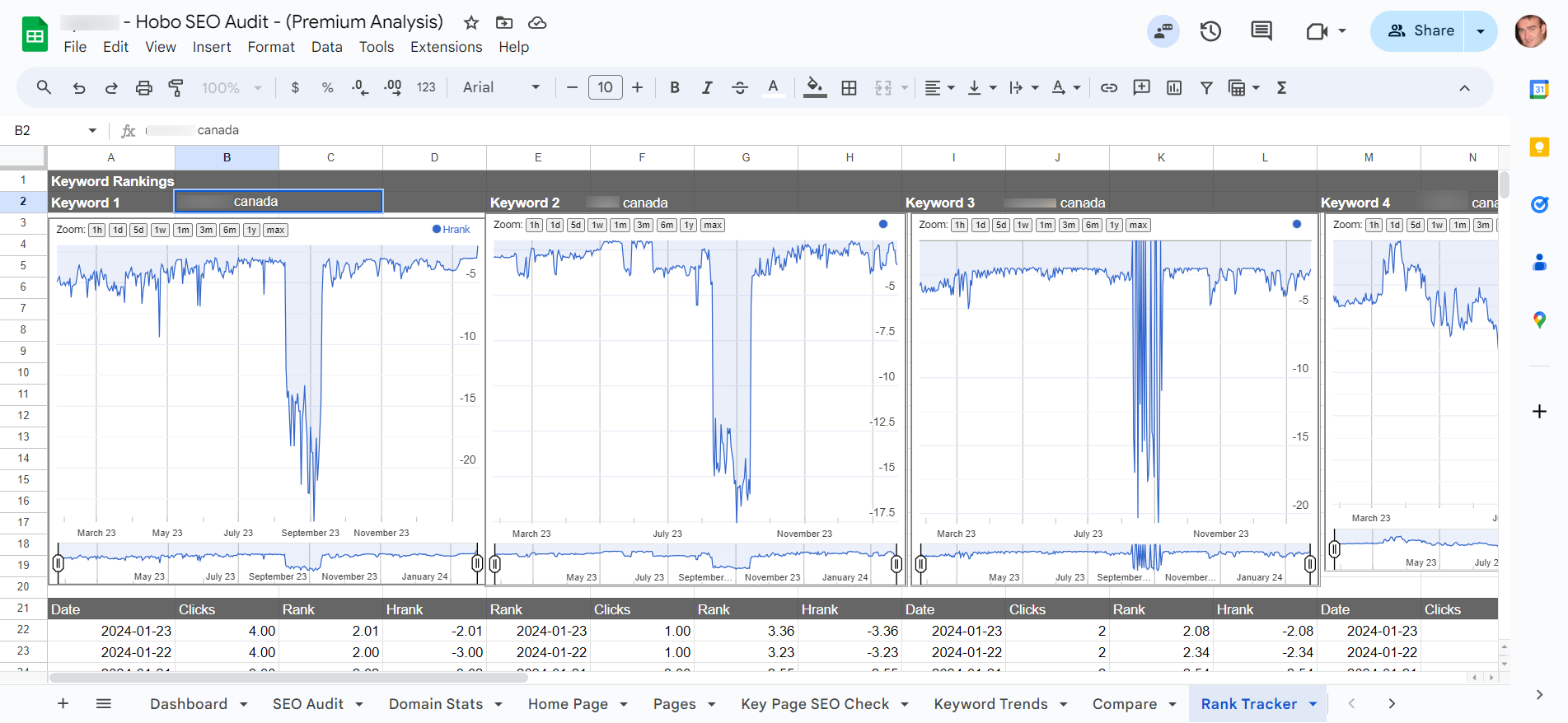
Data Privacy Considerations vs. SaaS Platforms: A core benefit emphasised for the Hobo SEO Dashboard is its approach to data privacy and security, particularly when contrasted with typical SaaS platforms.
The dashboard is designed to operate entirely within the confines of the user’s own Google account infrastructure (Google Sheets, Google Apps Script, Google Drive, Gmail).
This architecture means that sensitive user data, including Google Search Console access credentials/tokens and proprietary website crawl data from Screaming Frog, remains within the user’s controlled environment and “goes nowhere else”.
All data processing occurs via Google Apps Script running under the user’s authority. This stands in contrast to conventional SaaS models, where user data is typically uploaded to and processed on the vendor’s external servers.
This inherent data containment is presented as a significant advantage, especially for SEO agencies and consultants who handle confidential client data and may face stringent security or compliance requirements (e.g., GDPR).
By keeping data processing localised within the user’s Google ecosystem, the Hobo SEO Dashboard offers a higher degree of data control and potentially simplifies compliance efforts.
This focus on privacy is a strategic differentiator targeting users for whom data sovereignty is a primary concern.
Long-Term Cost Savings Analysis: The potential for significant long-term cost savings is another central pillar of the Hobo SEO Dashboard’s value proposition, primarily driven by its licensing model.
The dashboard’s one-time lifetime license fee of £499 stands in stark contrast to the recurring monthly or annual subscription fees characteristic of major all-in-one SEO SaaS platforms.
A comparative cost analysis presented in the documentation estimates that over a three-year period, the Hobo Dashboard combined with the necessary annual Screaming Frog license would cost approximately £1096 (based on a price comparison study from Hobo Web in April 2025).
This is substantially lower than the estimated three-year costs for entry-level plans of competitors like Ahrefs Lite (approx. £3714) or SEMrush Pro (approx. £4032).
Further contributing to cost control is the dashboard’s design for efficient Google API usage. It is engineered to perform its automated data fetching and processing tasks while staying within Google’s free tier API limits, even when managing numerous websites
This mitigates HUGELY the risk of incurring additional costs associated with excessive API calls, which can sometimes be a hidden expense with data-intensive tools.
Positioned explicitly as a “low-cost” alternative to “expensive SEO tools”, the Hobo SEO Dashboard offers a compelling financial argument for users who plan to utilise the tool over several years and are already incorporating Screaming Frog into their workflow.
The lifetime license model amortises the initial investment over time, leading to potentially substantial savings compared to ongoing subscription payments.
Hobo SEO Dashboard Enterprise Version
Beyond the standard Multi-Site version, Hobo Web offers a distinct Hobo SEO Dashboard Enterprise solution, tailored specifically for the challenges of managing SEO for large-scale, complex websites. This is explicitly described not as a self-serve product, but as a “comprehensive, yearly managed solution”.
Core Purpose and Differentiation: The Enterprise version’s primary objective is to tackle the complexities inherent in enterprise SEO, where site-wide performance metrics can often be misleading due to the scale and diversity of content within a single domain (e.g., distinct product sections, international subdirectories, extensive blogs or documentation).
Its core differentiator is the capability for granular, subfolder-level analysis. It achieves this through an “expert configuration” of the underlying Hobo SEO Dashboard technology, setting it up to treat designated website subfolders (examples given include /shop/, /blog/, /uk/, /de/, /support/, /docs/) as discrete analytical units.
This bespoke setup overcomes the limitations of many standard analysis tools that struggle with native subfolder segmentation, thereby providing true section-specific performance insights.
Service Model and Reporting: As a “yearly managed service,” the Enterprise offering means that Hobo Web takes responsibility for the initial setup, complex configuration for subfolder tracking, integration of segmented data sources (GSC, relevant SF crawls), automation setup, ongoing monitoring, and support throughout the contract term. This contrasts sharply with the self-setup and self-managed nature of the standard Multi-Site SEO Dashboard. The service includes automated, team-targeted reporting delivered via Google Sheets, ensuring that concise, relevant performance data and actionable insights reach the specific internal teams responsible for managing and optimising those particular website sections.
Target Audience and Cost: This solution is aimed squarely at large organisations managing complex websites where understanding performance at a subfolder level is critical for effective optimisation and accountability. The cost structure is implied to be a recurring annual fee based on a “Managed Service Agreement,” although the specific pricing is not provided in the documentation.
The Enterprise version represents a significant step up from the standard Dashboard, functioning as a specialised service rather than just a software product.
It addresses a specific, high-complexity use case (subfolder analysis on large sites) that the standard product does not natively support, justifying its managed service model and likely higher, recurring cost by shifting the burden of intricate configuration and maintenance from the client to the provider. More details on the Hobo SEO Dashboard Enterprise version of
Conclusion
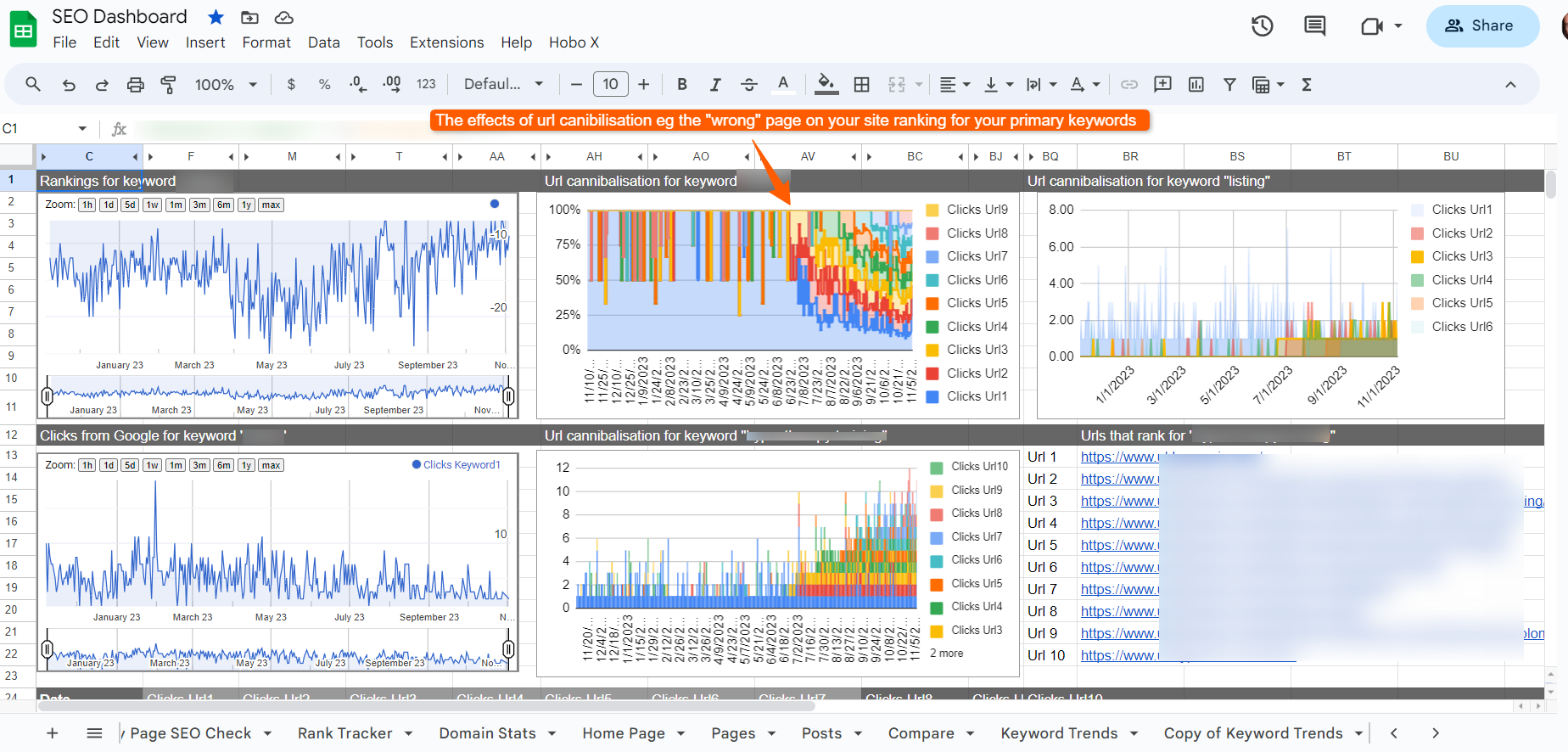
The Hobo SEO Dashboard Multi-Site emerges in 2025 as a specialised SEO automation tool operating within the user’s Google ecosystem (Sheets, Docs, Drive, GSC, Gmail).
Its core function is to streamline reporting and analysis for agencies and professionals managing multiple websites.
Summary of Findings:
- Automation Focus: Automates the generation and distribution of SEO reports derived from Google Search Console and Screaming Frog data, featuring unique “Winners and Losers” analysis tied to algorithm updates.
- Crawling Dependency: It does not perform website crawls itself but relies entirely on processing data from externally run Screaming Frog crawls, requiring users to have and maintain a separate Screaming Frog license.
- Target Audience: Primarily designed for SEO agencies, consultants, and web development companies managing numerous client websites. A separate Enterprise version caters to large single sites needing subfolder analysis.
- Prerequisites: Requires a Google Account (personal or Workspace) and a paid Screaming Frog license.
- Cost & Licensing: Features a one-time lifetime license fee (£499) for the dashboard, offering potential long-term savings, but necessitates the additional recurring cost of a Screaming Frog license.
- Technical Requirements: Demands moderate technical expertise for initial setup, involving configuration within Google Cloud Platform (GCP) and handling API permissions.
- Data Privacy: Offers significant data privacy advantages by keeping all user data and processing within the user’s controlled Google environment, a key differentiator from typical SaaS platforms.
- Support: General SEO resources (checklists, courses, articles) are available from Hobo Web, and specific post-purchase support for Hobo SEO Dashboard can be found here.
Key Strengths: The dashboard’s main strengths lie in its automation of reporting workflows across multiple sites, its insightful “Winners and Losers” analysis feature, the robust data privacy offered by its architecture, and its potentially cost-effective lifetime license model for long-term users already utilising Screaming Frog.
Key Limitations/Considerations: Significant considerations include the absolute dependency on owning and running Screaming Frog separately (adding cost and workflow steps), the non-trivial technical expertise required for setup, the lack of clarity regarding dedicated product support, and the fact that the standard version is not designed for granular subfolder analysis on large, complex websites (requiring the distinct Enterprise version).
Final Thought: The Hobo SEO Dashboard Multi-Site occupies a specific niche within the SEO tool landscape.
It appeals strongly to technically proficient users and agencies who prioritise data control, operate within the Google ecosystem, rely heavily on Screaming Frog for technical audits, and seek to automate reporting across numerous websites while potentially achieving long-term cost savings compared to subscription-based SaaS alternatives.
Its suitability depends heavily on aligning with these specific requirements and operational preferences. The existence of the Enterprise version further underscores its focus, offering a tailored (and likely more costly) managed solution for the distinct needs of large-scale website analysis.
Unlimited Clients with No Subscription fees and Lifetime Access.
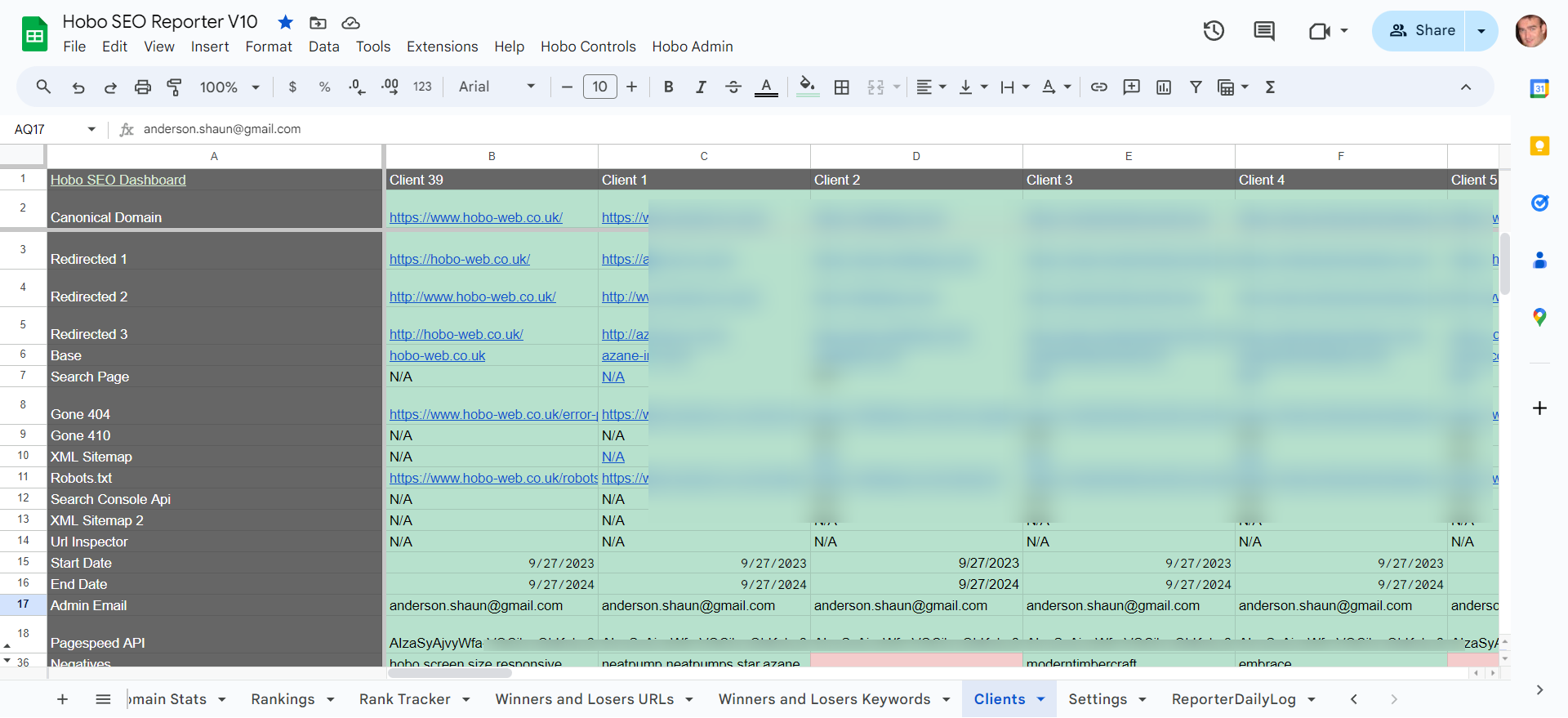
Hobo SEO Dashboard is a tool that helps marketers, SEOs and website developers explore and analyse Search Console data on any website directly in Google Sheets.
It will autonomously run regular reports on every client in your Search Console to a schedule you set.
When set up, you can rely on it to publish and update SEO audit reports for every client.
There is no limit to the number of clients you can process; it is only Google’s limit.
Publish Whitelabel SEO Audit Reports
The single purpose of the Hobo SEO Dashboard is to analyse multiple websites and publish white label SEO Audit reports for every client in your Search Console account.
Hobo SEO Dashboard FAQ
What is Hobo SEO Dashboard?
The Hobo SEO Dashboard in Google Sheets was conceived, developed and created by Shaun Anderson, also known as Hobo. Hobo SEO Dashboard is a tool in Google Sheets (not affiliated with Google) that helps marketers, SEOS, and website developers audit any website.
The dashboard will automatically generate regular SEO audit reports on a schedule set by the user.
Hobo SEO Dashboard uses Screaming Frog data to automate SEO analysis in Google Sheets. Screaming Frog is a website crawler that needs to be purchased separately. Hobo SEO Dashboard was designed to make life easier by automating professional SEO audit reporting.
What are some of the key benefits of the Hobo SEO Dashboard?
Hobo SEO Dashboard was developed to save time and money by automating the process of SEO audits and reporting. The dashboard offers a variety of time-saving and organisational benefits. Some of the key benefits of using Hobo SEO Dashboard include:
- Time Saver – Identifies website development priorities in minutes.
- Time Saver – Manages, stores, and collates Screaming Frog crawl files saved to Google Drive by Screaming Frog Scheduler in minutes.
- Time Saver – Tidies Screaming Frog files in Google Drive, moving used files to the Google Drive trash for 30 days – so restorable, too.
- Time Saver – Loads clients to a schedule set by the user.
- Time Saver – Built-in checks to make sure the user is sending clients the correct report.
- Organiser – One report sheet is continually updated for the client report.
- Time Saver – Emails the user and clients an SEO Audit based on Screaming Frog crawl data to a schedule set by the user.
- Time Saver – Performs an automatic check against Screaming Frog data and a Hobo Premium SEO Checklist.
- Secure – Automatic versioning, Backup, Sharing, Access Privileges, and Security are built in and handled by Google.
- Library-Based (App Script).
What are some of the key features of Hobo SEO Dashboard?
Hobo SEO Dashboard was developed with a variety of features to automate the SEO auditing and reporting process. Some of the key features of the dashboard include:
- Visualise Google algorithm impacts – The Domain Stats tab overview quickly highlights any major problems for the site.
- Visualise ranking performance for important keywords – The Ranktracker Tab overview quickly highlights any major rankings shifts for the site.
- Retrieving and Processing Specific SF Crawl Files from Google Drive – Finds and processes documents from Google Drive for SEO review.
- Cleans and Organises Google Drive – Manages space by moving used files to trash.
- Adheres to Personal Gmail Account Limits – Ensures operation within Google’s script runtime limits.
- No Limit on Client Sites Handling – Manages SEO tasks for any number of client sites.
- Schedules and Emails Client Reports – Automates reporting to clients on a schedule.
- Automatically loads the Next Client – Moves to the next client seamlessly after task completion.
- Runs Reports According to Schedule – Automates report generation and execution.
- Uses the Cache at All Times – Reduces API costs by utilising caching for data retrieval.
- Private – Your data is not accessed to shared with third parties.
- Secure: Uses Google security measures to secure your data.
- Low-Cost: Very competitively priced in comparison to some SEO software suites.
Can I use Hobo SEO Dashboard with a free Gmail Account?
Yes. Hobo SEO Dashboard can be used with a free personal Gmail account, but it is best used with a Google Workspace account. The user will need to create a new project in the Google Cloud console using a personal Gmail account and free API allowance. Hobo SEO Dashboard is developed in a free personal workspace environment to ensure compatibility and efficient usage of the free APIS Google provides.
What is Screaming Frog, and why do I need it for Hobo SEO Dashboard?
Screaming Frog is a website crawler that the user needs to purchase separately. Hobo SEO Dashboard uses Screaming Frog data to generate SEO analysis and reporting. The user needs to set up scheduled crawls in Screaming Frog, export the data files, and save them to Google Drive. Hobo SEO Dashboard will use the Screaming Frog files and then move them to the trash after 30 days. Hobo SEO Dashboard is not affiliated with Screaming Frog. A Screaming Frog user can tell you how instantly valuable this setup promises to be.
How do I add clients to the dashboard?
The user can add clients to the Clients tab manually or set up automatic reporting in the Report Scheduler to add clients automatically. Hobo SEO Dashboard can also be used to email SEO audit reports to clients on a regular schedule. The Client Email System was developed to automate the process of creating reports, sharing documents, and sending bulk emails. It will not arbitrarily send emails to just anyone. You will need to specifically approve every email recipient.
How do I use the Hobo SEO Dashboard?
The user can use the Hobo Controls and Hobo Admin menus in Google Sheets to operate the dashboard.
What is the Hobo Premium SEO Checklist?
The Hobo Premium SEO Checklist seamlessly integrates data from Screaming Frog, Google Webmaster Guidelines, Google Search Console, Google Analytics, website testing findings, and quality reviews. Using this intelligent system as the core, an SEO audit is automatically generated and copied over to the Client Report by the system. Hobo SEO Dashboard performs an automatic check against Screaming Frog data and the Hobo Premium SEO Checklist to make sure the website follows Google’s guidelines.
Current Status: 50% PRE-SALE!
Hobo SEO Dashboard is an autonomous SEO reporter in Google Sheets, and easy to set up.
If you are an SEO or web developer, or an SEO manager who manages many sites in Search Console and prefers to work in spreadsheets, this is for you.
Using the Hobo SEO Dashboard, you can quickly:
- Manage reporting on multiple Search Console accounts.
- Access Google APIS.
- Create and run your own reports.
- Analyse and store as much data as limits permit.
- Analyse the winner and loser reports for URLS.
- Analyse the winner and loser reports for KEYWORDS.
- Track and monitor rankings.
- Analyse website crawl files
- Perform an SEO audit.
- Most importantly for later, start to gather Client project data in a central Spreadsheet.
- Set up scheduling, regular email reports, and email traffic alerts (not in Beta versions).
… and all in Google Sheets, which turns out to be an incredibly cost-effective way to perform a quality audit on any website, without the need for other expensive tools.

